Paul van Yperen's Blog, page 286
December 19, 2017
Heinrich George
Huge, bear-like Heinrich George (1893–1946) was a famous German stage and film actor of the Weimar republic. He starred in such classics as Metropolis (1926) and Berlin Alexanderplatz (1931). Under the Nazi regime, the former Communist was initially not permitted to work but later appeared in notorious propaganda films as Jud Süss (1940). After the war he died of starvation in a Soviet concentration camp.
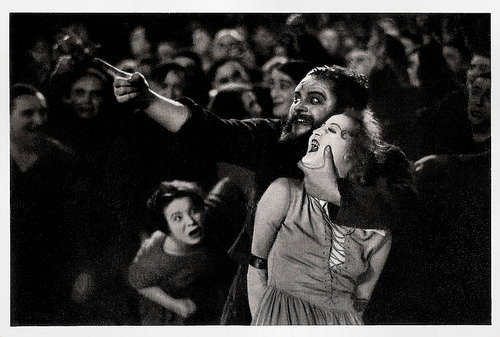
German collectors card by Ross Verlag in the series Vom Werden Deutscher Filmkunst - Der Stumme Film, picture, picture no. 143, group 43. Photo: Ufa. Caption: "Heinrich George plays the scene".
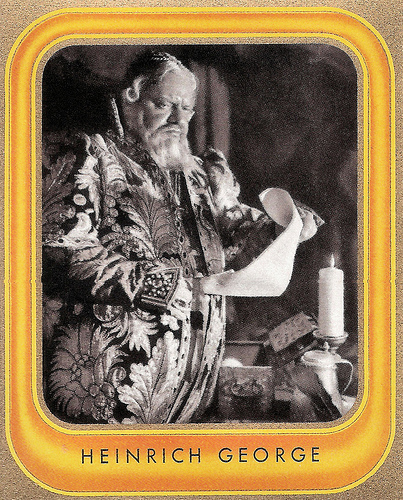
Small German collectors card in the Bunte Filmbilder series by G. Zuban, München, no. 190. Photo: Badal / Terra. Publicity still for Stjenka Rasin/Stenka Rasin (Alexandre Volkoff, 1936).
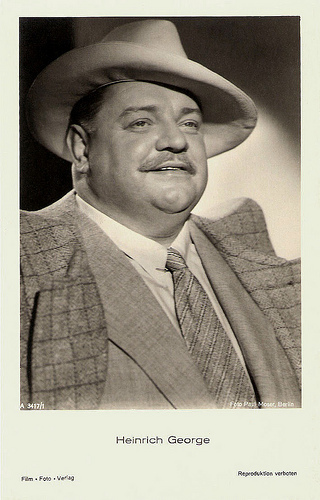
German postcard by Film-Foto-Verlag, no. 3417/1, 1941-1944. Photo: Paul Moser, Berlin.
Spooking Bertolt Brecht
Heinrich George was born Georg August Friedrich Hermann Schulz in Stettin, Pomerania, Germany (now Szczecin, Zachodniopomorskie, Poland) in 1893. He was the son of former naval officer August Schulz.
Before graduation, he left his school in Berlin and went to Szczecin for acting lessons. In the summer of 1912, only 19, he made his stage debut in the city of Kolberg as head waiter in the operetta Die keusche Susanne (The chaste Susanne) by Jean Gilbert.
After more stage engagements in Bromberg (now Bydgoszcz) and Neustrelitz, he took part as a volunteer in the First World War and in the winter of 1915 he was severely wounded. After his recovery, he worked in Dresden at the Albert-Theater (1917-1918), in Frankfurt am Main at the Schauspielhaus (1918-1921) and in Berlin at the Deutsches Theater (1921) under Max Reinhardt.
During the 1920s, he became one of the most renowned actors of the Weimar Republic with classic performances as Wallenstein, Falstaff, and Faust. He worked under such famous left-wing directors as Erwin Piscator and Bertolt Brecht. George reportedly spooked the young Brecht in his first directing job, a production of Arnolt Bronnen's Parracide (1922), when he refused to continue working with the director.
George was a member of the VDSt Greifswald and was active in the Communist Party of Germany. In 1923 he founded das Schauspielertheater with the actors Elisabeth Bergner and Alexander Granach to be able to work as independent artists. Between 1925 and 1929 he mainly played at the Volksbühne in plays directed by Erwin Piscator. In addition, he appeared at the Heidelberg Theater Festival on a regular basis (1926-1938). In 1927, he started directing stage plays himself.
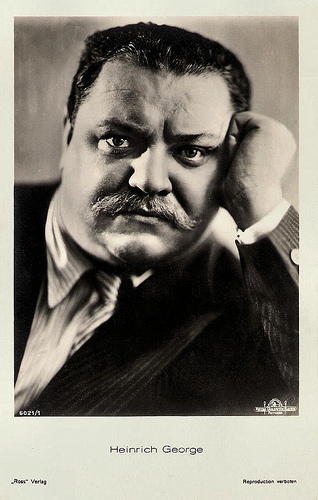
German postcard by Ross Verlag, no. 6021/1, 1931-1932. Photo: Metro-Goldwyn-Mayer. Publicity still for Menschen hinter Gittern/Men Behind Bars (Pál Fejös, 1931), German-language version of The Big House (George W. Hill, 1930), with Heinrich George in Wallace Beery's role, filmed by MGM parallel to the English-speaking version, at a time when good subtitles weren't yet in use.
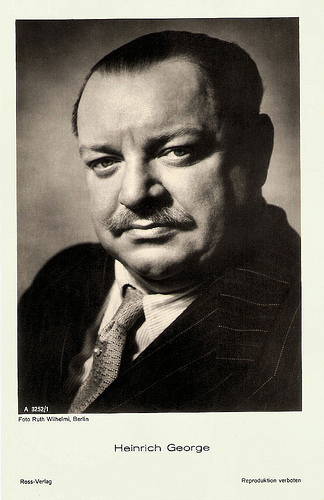
German postcard by Ross Verlag, no. A 3251/1, 1941-1944. Photo: Ruth Wilhelmi.
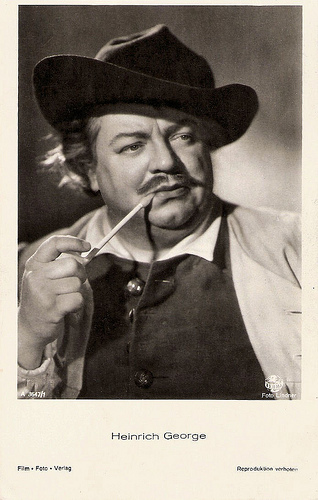
German postcard by Film-Foto-Verlag, no 3647/1, 1941-1944. Photo: Lindner / Terra. Publicity still for Andreas Schlüter (Herbert Maisch, 1942).
She-Who-Must-Be-Obeyed
In 1921 Heinrich George was directed by Ludwig Berger in his first silent film, Der Roman der Christine von Herre/The Novel of Christine von Herre (1921). His other early film appearances were mainly supporting parts in such films as Kean (Rudolph Biebrach, 1921) with Alexander Moissi , Lucrezia Borgia/Lucretia Borgia (Richard Oswald, 1922) featuring Liane Haid , and the Lulu adaptation Erdgeist/Earth Spirit (Leopold Jessner, 1923) starring Asta Nielsen .
In 1925 he appeared in the British fantasy film She (Leander De Cordova, G.B. Samuelson, 1925) starring Betty Blythe as She-Who-Must-Be-Obeyed of the frequently filmed H. Rider Haggard story. George had an important part in Fritz Lang‘s classic Metropolis (Fritz Lang, 1927) as Groth, the guardian of the Heart Machine. It was followed by several major parts in films by such directors as Richard Eichberg and Richard Oswald.
In Manolescu - Der König der Hochstapler/Manolescu (Viktor Tourjansky, 1929) he starred opposite the legendary Russian film star Ivan Mozzhukhin . Filmportal.de : “George became predominantly known as a film actor who portrayed characters that try to hide their sensibility behind a brutal attitude. His ‘massive appearance’ as well as his ‘elementary power’ were mentioned in nearly every contemporary review.”
He starred as the author Emile Zola in Dreyfus/The Dreyfus Case (Richard Oswald, 1930) opposite Fritz Kortner . In Berlin Alexanderplatz (Phil Jutzi, 1931), Heinrich George played his most famous role. In this first adaptation of the novel by Alfred Döblin he mesmerized as Franz Biberkopf both the public and the critics. It made him one of the most important film actors of Germany.
On account of his great success in Germany, he was engaged by Hollywood in 1931 where he starred in two German-language movies produced by Metro-Goldwyn-Mayer, including Menschen hinter Gittern/Men Behind Bars (Pál Fejös, 1931), a German-language version of The Big House (George W. Hill, 1931), with George in Wallace Beery’s role.
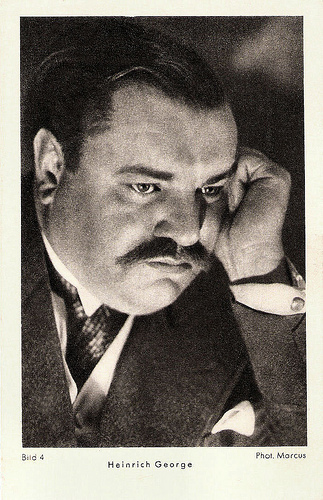
German postcard by Margarinewerk Eidelstedt Gebr. Fauser G.m.b.H., Holstein, Serie 1, no. Bild 4. Photo: Marcus.
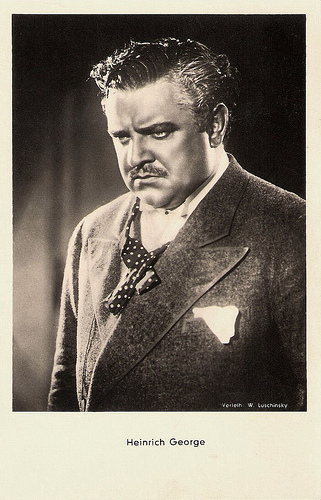
Austrian postcard by Iris-Verlag, no. 6305. Photo: Verleih W. Luschinsky.
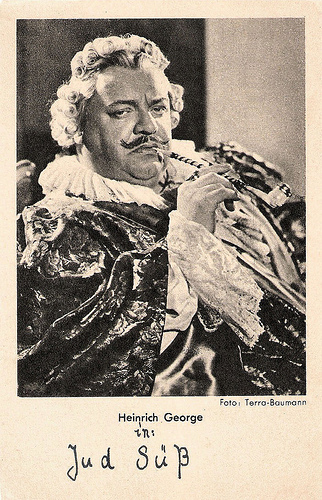
German postcard by Das Programm von Heute, Berlin. Photo: Baumann/Terra. Publicity still for Jud Süss (1940).
An Arrangement
Heinrich George married German actress Berta Drews in 1932. They would have two sons: Jan George (1932) and the well-known actor Götz George (1938), but the marital bliss was soon interrupted by Hitler’s takeover of the power in Germany in January 1933.
During the 1920s, Heinrich George had been active in the Communist Party of Germany, and the Nazis did not permit him to continue work. The desperate actor made an arrangement with the fascist regime and played a communist who converts to National Socialism in the propaganda film Hitlerjunge Quex/Hitler Youth Quex (Hans Steinhoff, 1933) based upon the life and death of Hitler Youth Herbert Norkus, killed while distributing flyers in a Communist neighborhood.
Hereafter the Nazis gave George an active role in their propaganda on film and radio. He became one of the leading representatives of Nazi cinema and proved himself to be a very versatile actor: in historic biopics such as Das unsterbliche Herz/The Immortal Hear and Andreas Schlüter he portrayed powerfully charismatic leaders who insist on unconditional obedience. In the anti-Semitic Jud Süß/Jew Süss (Veit Harlan, 1940) he starred as a pleasure-seeking Duke who hands over his country to a Jewish financial advisor, and in Kolberg/Burning Hearts (Veit Harlan, 1945) he played a mayor who calls on his citizens to defend the city against the Napoleonic troops.
He also appeared in non-propaganda films, such as the Henrik Ibsen adaptation Stützen der Gesellschaft/Pillars of Society (Detlev Sierck a.k.a. Douglas Sirk, 1935), the Zarah Leander vehicle Heimat/Homeland (Carl Froelich, 1938), and the popular hit Der Postmeister/The Stationmaster (Gustav Ucicky, 1940) based on the story by Alexander Pushkin.
In 1937 propaganda minister Joseph Goebbels named him ‘Staatsschauspieler’ (Actor of the State) and a year later he became artistic director of the Schiller Theater in Berlin. There he engaged several artists, who were ‘unerwünscht‘ (undesirable) by the regime. Among them were the art historian Wilhelm Fraenger who was fired in 1933 in Heidelberg for being a communist, the Catholic actor Robert Müller dismissed according to Nazi racial laws as a Jew, the communist graphic designer Karl Rössing and his pupil Günther Strupp. In December 1942, he took over his own department at the film production company Tobis.
After World War II, Heinrich George and his wife were arrested by the Soviet secret police. In June 1945, they were imprisoned in Berlin-Hohenschönhausen, and later interned in the former Nazi concentration camp Sachsenhausen, just north of Berlin. In 1946, Heinrich George died there at the age of 52. The death cause of the once so massive and powerful actor was starvation and exhaustion, even though official reports stated that he died ‘after an appendix operation’. The camp administration had urged the general practitioner, Dr. Schumann to do so.
In 1994, after the collapse of Communism and the removal of Soviet occupation troops from Germany, thousands of bones were found in the camp area. Heinrich George could be identified by comparing his DNA with that of his sons. The legendary actor got a final grave in a cemetery in Berlin and was officially rehabilitated in 1998.
Once George had described his famous acting technique as ‘controlled trance’. Filmportal.de : “His best screen moments occured in movies in which he could act in long unbroken scenes uninterrupted by reaction shots. Examples include his plea in Affäre Dreyfus (The Dreyfus Case) and the dance sequence in Der Postmeister”.
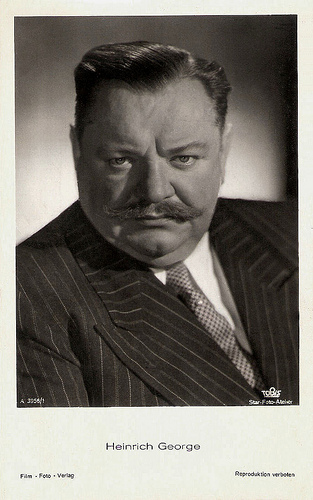
German postcard by Film-Foto-Verlag, no. A 3956/1, 1941-1944. Photo: Tobis / Star-Foto-Atelier.
Trailer Der Postmeister (1940). Source: Spuller (YouTube).
Sources: Film-Zeit.de (German), Wikipedia (English and German) and .

German collectors card by Ross Verlag in the series Vom Werden Deutscher Filmkunst - Der Stumme Film, picture, picture no. 143, group 43. Photo: Ufa. Caption: "Heinrich George plays the scene".

Small German collectors card in the Bunte Filmbilder series by G. Zuban, München, no. 190. Photo: Badal / Terra. Publicity still for Stjenka Rasin/Stenka Rasin (Alexandre Volkoff, 1936).

German postcard by Film-Foto-Verlag, no. 3417/1, 1941-1944. Photo: Paul Moser, Berlin.
Spooking Bertolt Brecht
Heinrich George was born Georg August Friedrich Hermann Schulz in Stettin, Pomerania, Germany (now Szczecin, Zachodniopomorskie, Poland) in 1893. He was the son of former naval officer August Schulz.
Before graduation, he left his school in Berlin and went to Szczecin for acting lessons. In the summer of 1912, only 19, he made his stage debut in the city of Kolberg as head waiter in the operetta Die keusche Susanne (The chaste Susanne) by Jean Gilbert.
After more stage engagements in Bromberg (now Bydgoszcz) and Neustrelitz, he took part as a volunteer in the First World War and in the winter of 1915 he was severely wounded. After his recovery, he worked in Dresden at the Albert-Theater (1917-1918), in Frankfurt am Main at the Schauspielhaus (1918-1921) and in Berlin at the Deutsches Theater (1921) under Max Reinhardt.
During the 1920s, he became one of the most renowned actors of the Weimar Republic with classic performances as Wallenstein, Falstaff, and Faust. He worked under such famous left-wing directors as Erwin Piscator and Bertolt Brecht. George reportedly spooked the young Brecht in his first directing job, a production of Arnolt Bronnen's Parracide (1922), when he refused to continue working with the director.
George was a member of the VDSt Greifswald and was active in the Communist Party of Germany. In 1923 he founded das Schauspielertheater with the actors Elisabeth Bergner and Alexander Granach to be able to work as independent artists. Between 1925 and 1929 he mainly played at the Volksbühne in plays directed by Erwin Piscator. In addition, he appeared at the Heidelberg Theater Festival on a regular basis (1926-1938). In 1927, he started directing stage plays himself.

German postcard by Ross Verlag, no. 6021/1, 1931-1932. Photo: Metro-Goldwyn-Mayer. Publicity still for Menschen hinter Gittern/Men Behind Bars (Pál Fejös, 1931), German-language version of The Big House (George W. Hill, 1930), with Heinrich George in Wallace Beery's role, filmed by MGM parallel to the English-speaking version, at a time when good subtitles weren't yet in use.

German postcard by Ross Verlag, no. A 3251/1, 1941-1944. Photo: Ruth Wilhelmi.

German postcard by Film-Foto-Verlag, no 3647/1, 1941-1944. Photo: Lindner / Terra. Publicity still for Andreas Schlüter (Herbert Maisch, 1942).
She-Who-Must-Be-Obeyed
In 1921 Heinrich George was directed by Ludwig Berger in his first silent film, Der Roman der Christine von Herre/The Novel of Christine von Herre (1921). His other early film appearances were mainly supporting parts in such films as Kean (Rudolph Biebrach, 1921) with Alexander Moissi , Lucrezia Borgia/Lucretia Borgia (Richard Oswald, 1922) featuring Liane Haid , and the Lulu adaptation Erdgeist/Earth Spirit (Leopold Jessner, 1923) starring Asta Nielsen .
In 1925 he appeared in the British fantasy film She (Leander De Cordova, G.B. Samuelson, 1925) starring Betty Blythe as She-Who-Must-Be-Obeyed of the frequently filmed H. Rider Haggard story. George had an important part in Fritz Lang‘s classic Metropolis (Fritz Lang, 1927) as Groth, the guardian of the Heart Machine. It was followed by several major parts in films by such directors as Richard Eichberg and Richard Oswald.
In Manolescu - Der König der Hochstapler/Manolescu (Viktor Tourjansky, 1929) he starred opposite the legendary Russian film star Ivan Mozzhukhin . Filmportal.de : “George became predominantly known as a film actor who portrayed characters that try to hide their sensibility behind a brutal attitude. His ‘massive appearance’ as well as his ‘elementary power’ were mentioned in nearly every contemporary review.”
He starred as the author Emile Zola in Dreyfus/The Dreyfus Case (Richard Oswald, 1930) opposite Fritz Kortner . In Berlin Alexanderplatz (Phil Jutzi, 1931), Heinrich George played his most famous role. In this first adaptation of the novel by Alfred Döblin he mesmerized as Franz Biberkopf both the public and the critics. It made him one of the most important film actors of Germany.
On account of his great success in Germany, he was engaged by Hollywood in 1931 where he starred in two German-language movies produced by Metro-Goldwyn-Mayer, including Menschen hinter Gittern/Men Behind Bars (Pál Fejös, 1931), a German-language version of The Big House (George W. Hill, 1931), with George in Wallace Beery’s role.

German postcard by Margarinewerk Eidelstedt Gebr. Fauser G.m.b.H., Holstein, Serie 1, no. Bild 4. Photo: Marcus.

Austrian postcard by Iris-Verlag, no. 6305. Photo: Verleih W. Luschinsky.

German postcard by Das Programm von Heute, Berlin. Photo: Baumann/Terra. Publicity still for Jud Süss (1940).
An Arrangement
Heinrich George married German actress Berta Drews in 1932. They would have two sons: Jan George (1932) and the well-known actor Götz George (1938), but the marital bliss was soon interrupted by Hitler’s takeover of the power in Germany in January 1933.
During the 1920s, Heinrich George had been active in the Communist Party of Germany, and the Nazis did not permit him to continue work. The desperate actor made an arrangement with the fascist regime and played a communist who converts to National Socialism in the propaganda film Hitlerjunge Quex/Hitler Youth Quex (Hans Steinhoff, 1933) based upon the life and death of Hitler Youth Herbert Norkus, killed while distributing flyers in a Communist neighborhood.
Hereafter the Nazis gave George an active role in their propaganda on film and radio. He became one of the leading representatives of Nazi cinema and proved himself to be a very versatile actor: in historic biopics such as Das unsterbliche Herz/The Immortal Hear and Andreas Schlüter he portrayed powerfully charismatic leaders who insist on unconditional obedience. In the anti-Semitic Jud Süß/Jew Süss (Veit Harlan, 1940) he starred as a pleasure-seeking Duke who hands over his country to a Jewish financial advisor, and in Kolberg/Burning Hearts (Veit Harlan, 1945) he played a mayor who calls on his citizens to defend the city against the Napoleonic troops.
He also appeared in non-propaganda films, such as the Henrik Ibsen adaptation Stützen der Gesellschaft/Pillars of Society (Detlev Sierck a.k.a. Douglas Sirk, 1935), the Zarah Leander vehicle Heimat/Homeland (Carl Froelich, 1938), and the popular hit Der Postmeister/The Stationmaster (Gustav Ucicky, 1940) based on the story by Alexander Pushkin.
In 1937 propaganda minister Joseph Goebbels named him ‘Staatsschauspieler’ (Actor of the State) and a year later he became artistic director of the Schiller Theater in Berlin. There he engaged several artists, who were ‘unerwünscht‘ (undesirable) by the regime. Among them were the art historian Wilhelm Fraenger who was fired in 1933 in Heidelberg for being a communist, the Catholic actor Robert Müller dismissed according to Nazi racial laws as a Jew, the communist graphic designer Karl Rössing and his pupil Günther Strupp. In December 1942, he took over his own department at the film production company Tobis.
After World War II, Heinrich George and his wife were arrested by the Soviet secret police. In June 1945, they were imprisoned in Berlin-Hohenschönhausen, and later interned in the former Nazi concentration camp Sachsenhausen, just north of Berlin. In 1946, Heinrich George died there at the age of 52. The death cause of the once so massive and powerful actor was starvation and exhaustion, even though official reports stated that he died ‘after an appendix operation’. The camp administration had urged the general practitioner, Dr. Schumann to do so.
In 1994, after the collapse of Communism and the removal of Soviet occupation troops from Germany, thousands of bones were found in the camp area. Heinrich George could be identified by comparing his DNA with that of his sons. The legendary actor got a final grave in a cemetery in Berlin and was officially rehabilitated in 1998.
Once George had described his famous acting technique as ‘controlled trance’. Filmportal.de : “His best screen moments occured in movies in which he could act in long unbroken scenes uninterrupted by reaction shots. Examples include his plea in Affäre Dreyfus (The Dreyfus Case) and the dance sequence in Der Postmeister”.

German postcard by Film-Foto-Verlag, no. A 3956/1, 1941-1944. Photo: Tobis / Star-Foto-Atelier.
Trailer Der Postmeister (1940). Source: Spuller (YouTube).
Sources: Film-Zeit.de (German), Wikipedia (English and German) and .
Published on December 19, 2017 22:00
December 18, 2017
Regimantas Adomaitis
Regimantas Adomaitis (1937) is a Lithuanian film and stage actor. He is known in Russia, Germany, and other countries besides Lithuania.
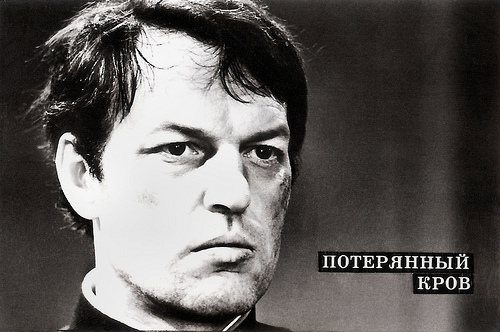
Soviet collectors card. Photo: publicity still for Poterjannyj krov. We could not identify the film.
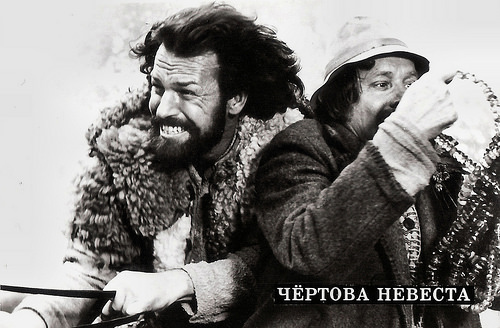
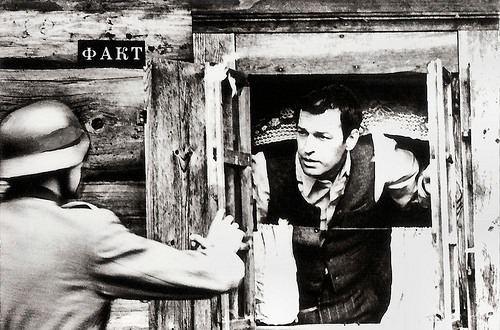
Soviet collectors card. Photo: publicity still for Velnio nuotaka/Cërtova nevesta/Devil's Bride (Arunas Zebriunas, 1973).Soviet collectors card. Photo: publicity still for Faktas/Facts (Almantas Grikevicius, 1981).
A Lithuanian Jesus Christ Superstar rock opera
Regimantas Adomaitis was born in Šiauliai, Lithuania in 1937. He graduated from the Faculty of Physics and Mathematics at Vilnius University. Later he studied acting at the acting department of the Vilnius Conservatory.
He made a debut in the theatre, and had engagements in Vilnius, Kaunas and Kapsukas. His film debut was Vienos dienos kronika/The Chronicle of one Day (Vytautas Zalakevicius, 1963) with Donatas Banionis .
In 1966 he had his breakthrough with Niekas nenorėjo mirti/Nobody Wanted to Die (Vytautas Žalakevičius,1966). This action drama is set in a small Lithuanian farming community after the Second World War. The village is divided as the communists battle those in favour of national independence. When the leader of the community is killed, the man's four sons, including Adomaitis, set out to avenge his death. Adomaitis, director Vytautas Žalakevičius. and cinematographer Jonas Gricius were awarded the USSR State Prize for the film in 1967.
That year, he also acted in the a-typical Soviet war film Vostochny koridor/Eastern Corridor (Valentin Vinogradov, 1966) with Lyudmila Abramova. In the historical drama Sergey Lazo (Aleksandr Gordon, 1968), he played the title role of the Communist leader Lazo.
Adomaitis appeared as Edmund in the Soviet Shakespeare adaptation Korol Lir/King Lear (Grigori Kozintsev, Iosif Shapiro, 1971), starring Juri Jarvet. The Russian composer Dmitri Shostakovich composed the score. Jugu Abraham at IMDb : “Kozintsev is one of least sung masters of Russian cinema. His cinema is very close to that of Tarkovsky and Sergei Paradjanov. Kozintsev's Lear is not a Lear that mourns his past and his daughters--his Lear is close to the soil, the plants, and all elements of nature. That's what makes Kozintsev's Shakespearean works outstanding.”
In 1973, Adomaitis appeared in the Soviet drama Eto sladkoe slovo - svoboda!/That Sweet Word: Liberty! (Vytautas Žalakevičius, 1973). The film was shot in Chile shortly before 1973 Chilean coup d'état. The basis for the plot is a real story: the escape from San-Carlos prison in Venezuela of three political prisoners. The film was entered into the 8th Moscow International Film Festival where it won the Golden Prize.
Velnio nuotaka/Cërtova nevesta/Devil's Bride (Arūnas Žebriūnas, 1974) is the first Lithuanian musical about the victory of love over the trickery of the Devil based on the book Baltaragio malūnas (Whitehorn Mill) by Kazys Boruta. Due to its popularity it is sometimes called a Lithuanian Jesus Christ Superstar rock opera.
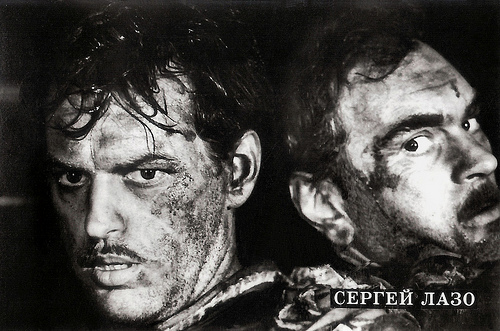
Soviet collectors card. Photo: publicity still for Sergey Lazo (Aleksandr Gordon, 1968).
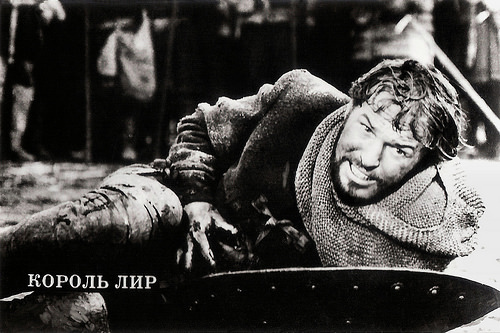
Soviet collectors card. Photo: publicity still for Korol Lir/King Lear (Grigori Kozintsev, Iosif Shapiro, 1971).
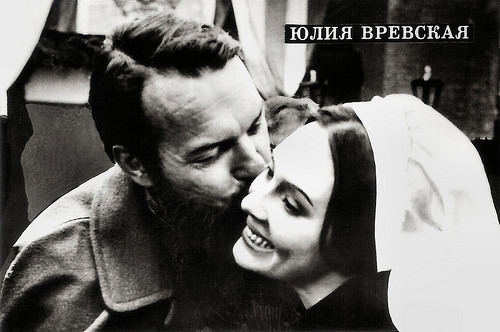
Soviet collectors card. Photo: publicity still for Yuliya Vrevskaya (Nikola Korabov, 1978) with Lyudmila Saveleva .
Power House
In East-Germany, Regimantas Adomaitis starred in Wolz - Leben und Verklärung eines deutschen Anarchisten/Wolz - Life and Illusion of a German Anarchist (Günter Reisch, 1974) with Heidemarie Wenzel. Tom Dooley at IMDb : “Part comedy at one point, part political statement and a definite swipe at National Socialism, it is very ambitious and it pulls it all off. It has a great musical score too and the music adds to the moods tenfold. The acting is superb and Regimantas Adomaitis as Wolz is a power house.”
For the DEFA, he also starred in Mann gegen Mann/Man Against Man (Kurt Maetzig, 1976). In the historical drama Yuliya Vrevskaya/Between the Tsar’s Court and the Battlefield (Nikola Korabov, 1978), Adomaitas played opposite Lyudmila Saveleva and Stefan Danailov.
Other films were the Maxim Gorky adaptation Vrag/Enemies (Rodion Nahapetov, 1978) with Innokentiy Smoktunovskiy, the Soviet-Italian drama La vita è bella/Life Is Beautiful (Grigoriy Chukhray, 1979) with Giancarlo Giannini and Ornella Muti , and Poloska neskoshennych dikikh tsvetov/A strip of unclosed wild flowers (Yuri Ilyenko, 1980).
He returned to East-Germany for the drama Die Verlobte/The Fiancee (Günter Reisch, Günther Rücker, 1980) with Jutta Wachowiak as a woman sentenced in 1934 to ten years in prison for antifascist activities. The love between her and her fiancée enables her to survive it.
He co-starred again with Donatas Banionis in the Soviet Lithuanian-language war film Gruppa krovi nol/Faktas/Facts (Almantas Grikevicius, 1981). At the 1981 Cannes Film Festival, actress Yelena Solovey won the award for Best Supporting Actress for her role in the film.
Other films include Iz zhizni otdykhayushchikh/Life on Holidays (Nikolay Gubenko, 1981), Skrydis per Atlanta/The Flight Across the Atlantic Ocean (Raimondas Vabalas, 1984), Es ist nicht leicht ein Gott zu sein/It’s Hard to be a God (Peter Fleischmann, 1989), the war drama Angely smerti/Angels of Death (Yuriy Ozerov, 1993), with Fedor Bondarchuk and Powers Boothe, and the French-Russian drama Tu es.../You are… (Vladimir Makeranets, 1995).
On TV, he appeared in the Soviet musical miniseries Trest, kotoryy lopnul/The Trust That Went Bust (Aleksandr Pavlovsky 1983) based on short stories by O. Henry. In 1985, Regimantas Adomaitis was a member of the jury at the 35th Berlin International Film Festival. Adomaitis has received many awards of recognition.
In 1988 he with other 34 prominent people, he created Sąjūdis Reform Movement, which eventually led to the declaration of independence of Lithuania on 11 March 1990. Regimantas Adomaitis now lives in Vilnius, the capital of Lithuania, where he works as an actor at the Lithuanian National Drama Theatre and regularly appears in TV series. His most recent film is the Norwegian drama Iskyss/The Ice Kiss (Knut Erik Jensen, 2008) with Ellen Dorrit Petersen. Adomaitis was married to singer Eugenia Baerite, who died in 2011. They have three children.
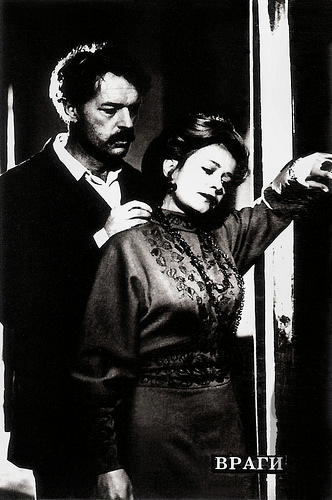
Soviet collectors card. Photo: publicity still for Vragi/Enemies (Rodion Nahapetov, 1979) with Elena Solovey.
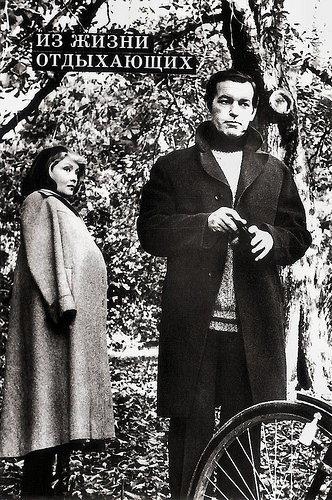
Soviet collectors card. Photo: publicity still for Iz zhizni otdykhayushchikh/Life on Holidays (Nikolay Gubenko, 1981) with Zhanna Bolotova.
Sources: Jugu Abraham (IMDb), Tom Dooley (IMDb), (IMDb), Mubi, AllMovie, Wikipedia and .

Soviet collectors card. Photo: publicity still for Poterjannyj krov. We could not identify the film.


Soviet collectors card. Photo: publicity still for Velnio nuotaka/Cërtova nevesta/Devil's Bride (Arunas Zebriunas, 1973).Soviet collectors card. Photo: publicity still for Faktas/Facts (Almantas Grikevicius, 1981).
A Lithuanian Jesus Christ Superstar rock opera
Regimantas Adomaitis was born in Šiauliai, Lithuania in 1937. He graduated from the Faculty of Physics and Mathematics at Vilnius University. Later he studied acting at the acting department of the Vilnius Conservatory.
He made a debut in the theatre, and had engagements in Vilnius, Kaunas and Kapsukas. His film debut was Vienos dienos kronika/The Chronicle of one Day (Vytautas Zalakevicius, 1963) with Donatas Banionis .
In 1966 he had his breakthrough with Niekas nenorėjo mirti/Nobody Wanted to Die (Vytautas Žalakevičius,1966). This action drama is set in a small Lithuanian farming community after the Second World War. The village is divided as the communists battle those in favour of national independence. When the leader of the community is killed, the man's four sons, including Adomaitis, set out to avenge his death. Adomaitis, director Vytautas Žalakevičius. and cinematographer Jonas Gricius were awarded the USSR State Prize for the film in 1967.
That year, he also acted in the a-typical Soviet war film Vostochny koridor/Eastern Corridor (Valentin Vinogradov, 1966) with Lyudmila Abramova. In the historical drama Sergey Lazo (Aleksandr Gordon, 1968), he played the title role of the Communist leader Lazo.
Adomaitis appeared as Edmund in the Soviet Shakespeare adaptation Korol Lir/King Lear (Grigori Kozintsev, Iosif Shapiro, 1971), starring Juri Jarvet. The Russian composer Dmitri Shostakovich composed the score. Jugu Abraham at IMDb : “Kozintsev is one of least sung masters of Russian cinema. His cinema is very close to that of Tarkovsky and Sergei Paradjanov. Kozintsev's Lear is not a Lear that mourns his past and his daughters--his Lear is close to the soil, the plants, and all elements of nature. That's what makes Kozintsev's Shakespearean works outstanding.”
In 1973, Adomaitis appeared in the Soviet drama Eto sladkoe slovo - svoboda!/That Sweet Word: Liberty! (Vytautas Žalakevičius, 1973). The film was shot in Chile shortly before 1973 Chilean coup d'état. The basis for the plot is a real story: the escape from San-Carlos prison in Venezuela of three political prisoners. The film was entered into the 8th Moscow International Film Festival where it won the Golden Prize.
Velnio nuotaka/Cërtova nevesta/Devil's Bride (Arūnas Žebriūnas, 1974) is the first Lithuanian musical about the victory of love over the trickery of the Devil based on the book Baltaragio malūnas (Whitehorn Mill) by Kazys Boruta. Due to its popularity it is sometimes called a Lithuanian Jesus Christ Superstar rock opera.

Soviet collectors card. Photo: publicity still for Sergey Lazo (Aleksandr Gordon, 1968).

Soviet collectors card. Photo: publicity still for Korol Lir/King Lear (Grigori Kozintsev, Iosif Shapiro, 1971).

Soviet collectors card. Photo: publicity still for Yuliya Vrevskaya (Nikola Korabov, 1978) with Lyudmila Saveleva .
Power House
In East-Germany, Regimantas Adomaitis starred in Wolz - Leben und Verklärung eines deutschen Anarchisten/Wolz - Life and Illusion of a German Anarchist (Günter Reisch, 1974) with Heidemarie Wenzel. Tom Dooley at IMDb : “Part comedy at one point, part political statement and a definite swipe at National Socialism, it is very ambitious and it pulls it all off. It has a great musical score too and the music adds to the moods tenfold. The acting is superb and Regimantas Adomaitis as Wolz is a power house.”
For the DEFA, he also starred in Mann gegen Mann/Man Against Man (Kurt Maetzig, 1976). In the historical drama Yuliya Vrevskaya/Between the Tsar’s Court and the Battlefield (Nikola Korabov, 1978), Adomaitas played opposite Lyudmila Saveleva and Stefan Danailov.
Other films were the Maxim Gorky adaptation Vrag/Enemies (Rodion Nahapetov, 1978) with Innokentiy Smoktunovskiy, the Soviet-Italian drama La vita è bella/Life Is Beautiful (Grigoriy Chukhray, 1979) with Giancarlo Giannini and Ornella Muti , and Poloska neskoshennych dikikh tsvetov/A strip of unclosed wild flowers (Yuri Ilyenko, 1980).
He returned to East-Germany for the drama Die Verlobte/The Fiancee (Günter Reisch, Günther Rücker, 1980) with Jutta Wachowiak as a woman sentenced in 1934 to ten years in prison for antifascist activities. The love between her and her fiancée enables her to survive it.
He co-starred again with Donatas Banionis in the Soviet Lithuanian-language war film Gruppa krovi nol/Faktas/Facts (Almantas Grikevicius, 1981). At the 1981 Cannes Film Festival, actress Yelena Solovey won the award for Best Supporting Actress for her role in the film.
Other films include Iz zhizni otdykhayushchikh/Life on Holidays (Nikolay Gubenko, 1981), Skrydis per Atlanta/The Flight Across the Atlantic Ocean (Raimondas Vabalas, 1984), Es ist nicht leicht ein Gott zu sein/It’s Hard to be a God (Peter Fleischmann, 1989), the war drama Angely smerti/Angels of Death (Yuriy Ozerov, 1993), with Fedor Bondarchuk and Powers Boothe, and the French-Russian drama Tu es.../You are… (Vladimir Makeranets, 1995).
On TV, he appeared in the Soviet musical miniseries Trest, kotoryy lopnul/The Trust That Went Bust (Aleksandr Pavlovsky 1983) based on short stories by O. Henry. In 1985, Regimantas Adomaitis was a member of the jury at the 35th Berlin International Film Festival. Adomaitis has received many awards of recognition.
In 1988 he with other 34 prominent people, he created Sąjūdis Reform Movement, which eventually led to the declaration of independence of Lithuania on 11 March 1990. Regimantas Adomaitis now lives in Vilnius, the capital of Lithuania, where he works as an actor at the Lithuanian National Drama Theatre and regularly appears in TV series. His most recent film is the Norwegian drama Iskyss/The Ice Kiss (Knut Erik Jensen, 2008) with Ellen Dorrit Petersen. Adomaitis was married to singer Eugenia Baerite, who died in 2011. They have three children.

Soviet collectors card. Photo: publicity still for Vragi/Enemies (Rodion Nahapetov, 1979) with Elena Solovey.

Soviet collectors card. Photo: publicity still for Iz zhizni otdykhayushchikh/Life on Holidays (Nikolay Gubenko, 1981) with Zhanna Bolotova.
Sources: Jugu Abraham (IMDb), Tom Dooley (IMDb), (IMDb), Mubi, AllMovie, Wikipedia and .
Published on December 18, 2017 22:00
December 17, 2017
Régina Badet
During the Belle Epoque, French dancer and actress Régina Badet (1876-1949) was a star of the Opéra-Comique in Paris. She also had a career in the French silent cinema.
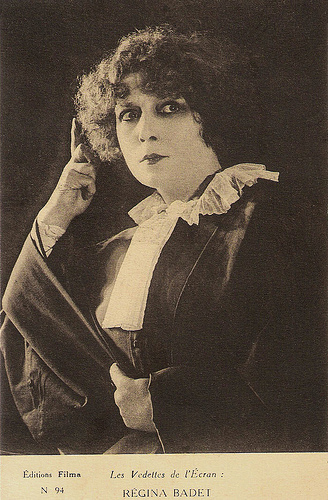
French postcard in the Les Vedettes de l'Écran series by Editions Filma, no. 94.
The New Paris Pet
Anne Régina Badet was born in 1876 in Bordeaux in the Gironde region of France.
She made an early stage debut at the Grand Théâtre de Bordeaux where she was a principal dancer in 1890. In 1900 she started a brilliant Parisian career as an actress and dancer. In 1904, Madame Badet became a major star of the Opéra-Comique.
The Los Angeles Herald (1906) described Badet as the 'new Paris pet' and that her dances in the Opera Aphrodite had caused a furor among theatregoers.
A critic wrote that he went to see the performance because the opera was a 'masterpiece' and because he wanted to see star soprano Mary Garden's interpretation of her role. Instead, he reported that he was most drawn to the performance by Régina Badet.
She was particularly noted in 1910 for her role as Conchita Perez in the stage production of La Femme et le Pantin (The Woman and the Puppet) by Pierre Louÿs and Pierre Frondaie.
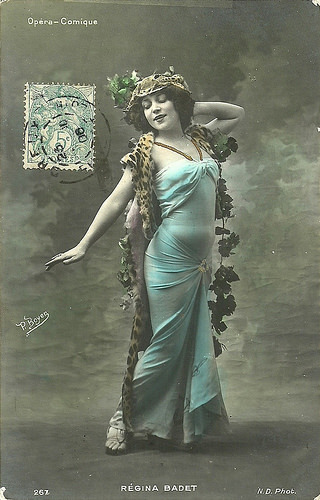
French postcard, no. 267. Photo: N.D. Caption: Régina Badet. Opéra-Comique.
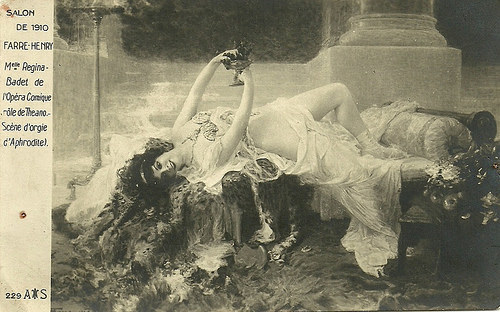
French postcard by A.S., no. 229. Painting for the Salon de 1910 by Farre-Henry, 'Mlle Regina Badet de l'Opéra Comique, rôle de Théano. Scène d'orgie d' Aphrodite.'
An appealingly subtle actress, as well as a looker
Between 1908 and 1922, Régina Badet played in a dozen films. Her film debut was in the early silent film Le Secret de Myrto/Myrto's Secret (1908) for Pathé Frères.
The following year, she appeared for Pathé in Carmen (André Calmettes, Charles Le Bargy, 1909) with Max Dearly , and in the Film D'Art production Le Retour d'Ulysse/The Return of Ulysses (André Calmettes, Charles Le Bargy, 1909) with Paul Mounet as the legendary Greek hero.
In the next decade she appeared in several films by Louis Mercanton, including Le spectre du passé/The specter of the past (René Hervil, Louis Mercanton, 1913) with Gabriel de Gravone , Vendetta (René Hervil, Louis Mercanton, 1914) with Jean Angelo , and Le lotus d'or/The Golden Lotus (Louis Mercanton, 1916).
F Gwynplaine MacIntyre at IMDb about Le Lotus d'or: "This silent movie felt like an opera with no music. I didn't much fancy the moralistic ending; it implies that a sensual woman is inherently so immoral that she must die. As portrayed by Regina Badet - an appealingly subtle actress, as well as a looker - Leah isn't really evil."
Her final film was Maître Évora/Mr. Evora (Gaston Roudès, 1922) with Maurice Schutz . She abandoned the stage and the screen permanently in the early 1920s.
Régina Badet died in her hometown Bordeaux in 1949.
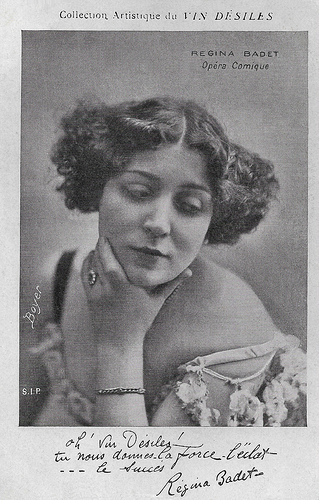
French postcard by S.I.P. Photo: Boyer. Publicity for Vins Désiles. Caption: Oh! Vins Désiles! You give us the force, the sparkle ... the success.
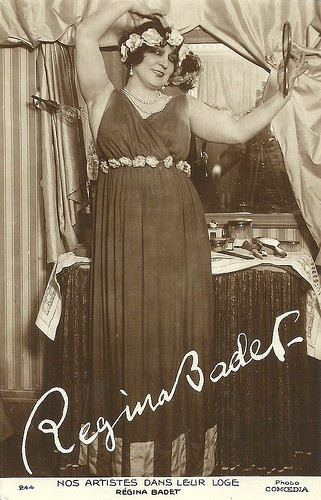
French postcard by Editions Lafayette in the Nos artistes dans leur loge series, no. 244. Photo: Comoedia.
Sources: Lynn Garafola (Legacies of Twentieth-Century Dance), The Cabinet Card Gallery, Wikipedia (French) and .

French postcard in the Les Vedettes de l'Écran series by Editions Filma, no. 94.
The New Paris Pet
Anne Régina Badet was born in 1876 in Bordeaux in the Gironde region of France.
She made an early stage debut at the Grand Théâtre de Bordeaux where she was a principal dancer in 1890. In 1900 she started a brilliant Parisian career as an actress and dancer. In 1904, Madame Badet became a major star of the Opéra-Comique.
The Los Angeles Herald (1906) described Badet as the 'new Paris pet' and that her dances in the Opera Aphrodite had caused a furor among theatregoers.
A critic wrote that he went to see the performance because the opera was a 'masterpiece' and because he wanted to see star soprano Mary Garden's interpretation of her role. Instead, he reported that he was most drawn to the performance by Régina Badet.
She was particularly noted in 1910 for her role as Conchita Perez in the stage production of La Femme et le Pantin (The Woman and the Puppet) by Pierre Louÿs and Pierre Frondaie.

French postcard, no. 267. Photo: N.D. Caption: Régina Badet. Opéra-Comique.

French postcard by A.S., no. 229. Painting for the Salon de 1910 by Farre-Henry, 'Mlle Regina Badet de l'Opéra Comique, rôle de Théano. Scène d'orgie d' Aphrodite.'
An appealingly subtle actress, as well as a looker
Between 1908 and 1922, Régina Badet played in a dozen films. Her film debut was in the early silent film Le Secret de Myrto/Myrto's Secret (1908) for Pathé Frères.
The following year, she appeared for Pathé in Carmen (André Calmettes, Charles Le Bargy, 1909) with Max Dearly , and in the Film D'Art production Le Retour d'Ulysse/The Return of Ulysses (André Calmettes, Charles Le Bargy, 1909) with Paul Mounet as the legendary Greek hero.
In the next decade she appeared in several films by Louis Mercanton, including Le spectre du passé/The specter of the past (René Hervil, Louis Mercanton, 1913) with Gabriel de Gravone , Vendetta (René Hervil, Louis Mercanton, 1914) with Jean Angelo , and Le lotus d'or/The Golden Lotus (Louis Mercanton, 1916).
F Gwynplaine MacIntyre at IMDb about Le Lotus d'or: "This silent movie felt like an opera with no music. I didn't much fancy the moralistic ending; it implies that a sensual woman is inherently so immoral that she must die. As portrayed by Regina Badet - an appealingly subtle actress, as well as a looker - Leah isn't really evil."
Her final film was Maître Évora/Mr. Evora (Gaston Roudès, 1922) with Maurice Schutz . She abandoned the stage and the screen permanently in the early 1920s.
Régina Badet died in her hometown Bordeaux in 1949.

French postcard by S.I.P. Photo: Boyer. Publicity for Vins Désiles. Caption: Oh! Vins Désiles! You give us the force, the sparkle ... the success.

French postcard by Editions Lafayette in the Nos artistes dans leur loge series, no. 244. Photo: Comoedia.
Sources: Lynn Garafola (Legacies of Twentieth-Century Dance), The Cabinet Card Gallery, Wikipedia (French) and .
Published on December 17, 2017 22:00
December 16, 2017
Lilian Constantini
Lilian Constantini (1902-1982) was a French dancer and actress, before marrying industrialist Charles Schneider. During the silent film ear, she often worked with director Jacques Robert.
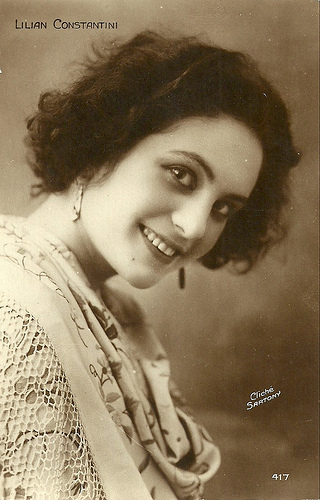
French postcard by Editions Cinémagazine, no. 417. Photo: Sartony.
Mata Hari
Lilian Constantini was born Lilian Louise Hélène Chapiro-Volpert in Paris in 1902. She was the granddaughter of French Socialist politician Jules Guesde, and daughter of Boris Chapiro-Volpert, and Louise Bazile-Guesde.
Her mother separated from Chapiro-Volpert in 1917 and remarried in 1924 with the - 18 years younger - Parisian film director and former actor Gustave Jacques Robert Kneubühler, better known as Jacques Robert. Constantini, only 7 years younger than Robert, was witness at the marriage.
From 1921 she acted in a whole range films by Jacques Robert; actually, she acted in all of his films apart from Le comte Kostia/Count Kostia (Jacques Robert, 1925).
Constantini debuted in Robert’s Gaumont production La vivante épingle/The living pin (Jacques Robert, 1922), starring Jean Toulout . In Robert’s next Gaumont film La bouquetière des innocents/The Innocent Flower Girl (Jacques Robert, 1922), Constantini already played a substantial part as Marie Concini, opposite the main actress Claude Merelle , who played the double role of Margot the flower girl and Leonor Galligalt.
The third film of Robert and Constantini was the Honoré de Balzac adaptation Le cousin Pons/Cousin Pons (Jacques Robert, 1924), in which Constantini acted as Héloïse Brisetout opposite Maurice de Féraudy as Pons. In their next film, Naples au baiser du feu/Naples at the kiss of fire (Jacques Robert, Serge Nadejdine, 1925) Constantini had a major part opposite Gaston Modot and Gina Manès .
After Gauthier Debere’s short La leçon bien apprise (1926), Constantini had the lead opposite in La chèvre aux pieds d’or/The Goat with the Golden Feet (Jacques Robert, 1926), adapted from the novel by Charles-Henry Hirsch and loosely based on the life story of Mata Hari.
Toutcha (Constantini), a Russian girl, loses her anarchist lover to the Russian police – he is murdered. Forced by hunger she bends to police chief baron Friedrich (Pierre Alcover) and becomes a Russian spy while dancing ‘Ballet Russe’-style in Paris as ‘The Goat with the Golden Feet’. One day, by their mutual friend Ursac (Max Maxudian), she meets a French lawyer, Marc Brégyl ( Romuald Joubé ) and they fall in love. Happy to escape the clutches of the baron, she joins Marc to his country house, but out of boredom she invites her theatre friends, whose wild parties drive the lawyer to madness, so he breaks with her. Time after, he receives a letter from her. The First World War has started, Toutcha is arrested as a spy and she asks him to defend her. With all his powers he does so, but in vain. Toutcha will be executed.
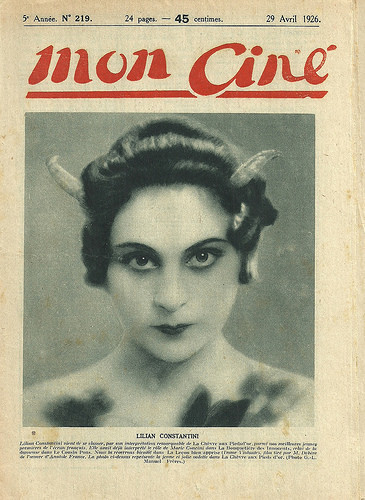
French magazine cover. Lilian Constantini in La chèvre aux pieds d'or (Jacques Robert, 1926). Cover of Mon Ciné, V, 219, 29 April 1926.
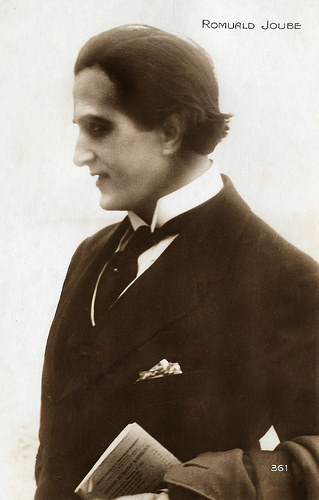
Romuald Joubé. French postcard by Cinémagazine-Edition, Paris, no. 361.
Heir of the biggest French steel and armaments factory
Lilian Constantini's subsequent film with Jacques Robert was again a spy themed story, En plongée/Diving, made in 1926 but released in 1928, with Constantini in the lead and with Daniel Mendaille and again Pierre Alcover as her co-stars. It was Robert’s last film. He would die in 1928, at the age of only 38. The film, based on the story Fragments d’épaves by Bernard Frank was filmed in Brittany. Other sources say it pretended to be Brittany but was shot in Monaco.
In 1928 Constantini acted opposite Georges Vallée in Germaine Dulac’s film Celles qui s'en font. During a period of “discophillia” in France, Dulac made this musical film, intended to be shown with records. Celles qui s’en font was split into two parts, with each part presenting a short story to match one of two tracks. Both stories feature dancer Lillian Constantini playing a female protagonist shunned by society (a theme dear to Dulac) and fallen on hard times.
In 1929, Constantini had the female lead in Chacun porte sa croix/Everyone carries his cross (Jean Choux, 1929) about a man who forbids his wife and child to go to church until misery happens. She again played the lead in a spy story by Choux, Espionnage ou la guerre sans armes/Spying or Unarmed War (Jean Choux, 1929), a romanticised depiction of the life of female spy Louise de Bettignies. Then followed another lead in Sa maman/His mom (Gaston Mouru de Lacotte, 1929).
In 1930 she had the female lead in her first sound film, L'étrange fiancée/The strange fiancée (George Pallu, 1930), with Henry Baudin as a Caligari-like mad scientist. In post-production they had given Lilian such a strange voice, that people started laughing in the cinema and Constantini protested after the first night.
After an interval of several years, Constantini had a regular lead in three adaptations of mystery dramas by Marcel Allain: Lui... ou... elle/Him ... or ... she (Roger Capellani, 1934), Vilaine histoire/An ugly story (Christian-Jaque, 1935) and Crime d’amour/Crime of love (Roger Capellani, 1935), always with Robert Ancelin and Lucien Arnaud in the male leads as the amateur detective and the professional policeman. Constantini’s last film was Jean de Limur’s comedy Le coup de trois/The three (1936), starring René Lefèvre .
In 1943 Lilian Constantini/Volpert married industrialist Charles Schneider (1898-1960), cousin of filmmaker Germaine Dulac and heir of the biggest French steel and armaments factory Schneider-Creusot. After serving in the First World War he was fired from the family business in 1924, because of a conflict with his father Eugène Schneider II. He then worked at the Gaumont Film company, but in 1942 after the death of his father he took over the family business with his brother Jean.
Schneider and Constantini had one son, who died early, but two daughters lived on: Dominique (1942) and Catherine (1944). Dominique became writer and named herself Schneidre. She published e.g. on her mother the book Fortune de mère (2001). Catherine Schneider was in 1975-1977 the third wife of filmmaker Roger Vadim, with whom she has a son, Vania Plémiannikov.
Lilian Constantini/Volpert/Schneider died in 1982 in Saint-Tropez, France. She was 79.
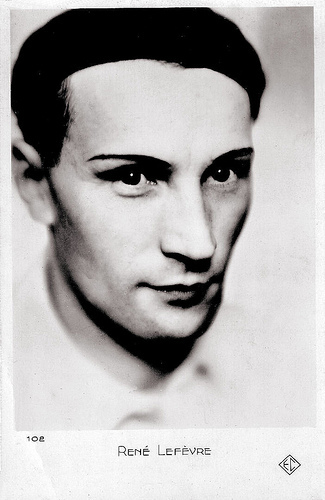
René Lefèvre . French postcard by Éditions Chantal (EC), Paris, no. 102.
Celles qui s'en font (Germaine Dulac, 1930). Source: Georgette 14 (YouTube).
Sources: Unifrance, Rochelle Sara Miller, Wikipedia (French and English), and .

French postcard by Editions Cinémagazine, no. 417. Photo: Sartony.
Mata Hari
Lilian Constantini was born Lilian Louise Hélène Chapiro-Volpert in Paris in 1902. She was the granddaughter of French Socialist politician Jules Guesde, and daughter of Boris Chapiro-Volpert, and Louise Bazile-Guesde.
Her mother separated from Chapiro-Volpert in 1917 and remarried in 1924 with the - 18 years younger - Parisian film director and former actor Gustave Jacques Robert Kneubühler, better known as Jacques Robert. Constantini, only 7 years younger than Robert, was witness at the marriage.
From 1921 she acted in a whole range films by Jacques Robert; actually, she acted in all of his films apart from Le comte Kostia/Count Kostia (Jacques Robert, 1925).
Constantini debuted in Robert’s Gaumont production La vivante épingle/The living pin (Jacques Robert, 1922), starring Jean Toulout . In Robert’s next Gaumont film La bouquetière des innocents/The Innocent Flower Girl (Jacques Robert, 1922), Constantini already played a substantial part as Marie Concini, opposite the main actress Claude Merelle , who played the double role of Margot the flower girl and Leonor Galligalt.
The third film of Robert and Constantini was the Honoré de Balzac adaptation Le cousin Pons/Cousin Pons (Jacques Robert, 1924), in which Constantini acted as Héloïse Brisetout opposite Maurice de Féraudy as Pons. In their next film, Naples au baiser du feu/Naples at the kiss of fire (Jacques Robert, Serge Nadejdine, 1925) Constantini had a major part opposite Gaston Modot and Gina Manès .
After Gauthier Debere’s short La leçon bien apprise (1926), Constantini had the lead opposite in La chèvre aux pieds d’or/The Goat with the Golden Feet (Jacques Robert, 1926), adapted from the novel by Charles-Henry Hirsch and loosely based on the life story of Mata Hari.
Toutcha (Constantini), a Russian girl, loses her anarchist lover to the Russian police – he is murdered. Forced by hunger she bends to police chief baron Friedrich (Pierre Alcover) and becomes a Russian spy while dancing ‘Ballet Russe’-style in Paris as ‘The Goat with the Golden Feet’. One day, by their mutual friend Ursac (Max Maxudian), she meets a French lawyer, Marc Brégyl ( Romuald Joubé ) and they fall in love. Happy to escape the clutches of the baron, she joins Marc to his country house, but out of boredom she invites her theatre friends, whose wild parties drive the lawyer to madness, so he breaks with her. Time after, he receives a letter from her. The First World War has started, Toutcha is arrested as a spy and she asks him to defend her. With all his powers he does so, but in vain. Toutcha will be executed.

French magazine cover. Lilian Constantini in La chèvre aux pieds d'or (Jacques Robert, 1926). Cover of Mon Ciné, V, 219, 29 April 1926.

Romuald Joubé. French postcard by Cinémagazine-Edition, Paris, no. 361.
Heir of the biggest French steel and armaments factory
Lilian Constantini's subsequent film with Jacques Robert was again a spy themed story, En plongée/Diving, made in 1926 but released in 1928, with Constantini in the lead and with Daniel Mendaille and again Pierre Alcover as her co-stars. It was Robert’s last film. He would die in 1928, at the age of only 38. The film, based on the story Fragments d’épaves by Bernard Frank was filmed in Brittany. Other sources say it pretended to be Brittany but was shot in Monaco.
In 1928 Constantini acted opposite Georges Vallée in Germaine Dulac’s film Celles qui s'en font. During a period of “discophillia” in France, Dulac made this musical film, intended to be shown with records. Celles qui s’en font was split into two parts, with each part presenting a short story to match one of two tracks. Both stories feature dancer Lillian Constantini playing a female protagonist shunned by society (a theme dear to Dulac) and fallen on hard times.
In 1929, Constantini had the female lead in Chacun porte sa croix/Everyone carries his cross (Jean Choux, 1929) about a man who forbids his wife and child to go to church until misery happens. She again played the lead in a spy story by Choux, Espionnage ou la guerre sans armes/Spying or Unarmed War (Jean Choux, 1929), a romanticised depiction of the life of female spy Louise de Bettignies. Then followed another lead in Sa maman/His mom (Gaston Mouru de Lacotte, 1929).
In 1930 she had the female lead in her first sound film, L'étrange fiancée/The strange fiancée (George Pallu, 1930), with Henry Baudin as a Caligari-like mad scientist. In post-production they had given Lilian such a strange voice, that people started laughing in the cinema and Constantini protested after the first night.
After an interval of several years, Constantini had a regular lead in three adaptations of mystery dramas by Marcel Allain: Lui... ou... elle/Him ... or ... she (Roger Capellani, 1934), Vilaine histoire/An ugly story (Christian-Jaque, 1935) and Crime d’amour/Crime of love (Roger Capellani, 1935), always with Robert Ancelin and Lucien Arnaud in the male leads as the amateur detective and the professional policeman. Constantini’s last film was Jean de Limur’s comedy Le coup de trois/The three (1936), starring René Lefèvre .
In 1943 Lilian Constantini/Volpert married industrialist Charles Schneider (1898-1960), cousin of filmmaker Germaine Dulac and heir of the biggest French steel and armaments factory Schneider-Creusot. After serving in the First World War he was fired from the family business in 1924, because of a conflict with his father Eugène Schneider II. He then worked at the Gaumont Film company, but in 1942 after the death of his father he took over the family business with his brother Jean.
Schneider and Constantini had one son, who died early, but two daughters lived on: Dominique (1942) and Catherine (1944). Dominique became writer and named herself Schneidre. She published e.g. on her mother the book Fortune de mère (2001). Catherine Schneider was in 1975-1977 the third wife of filmmaker Roger Vadim, with whom she has a son, Vania Plémiannikov.
Lilian Constantini/Volpert/Schneider died in 1982 in Saint-Tropez, France. She was 79.

René Lefèvre . French postcard by Éditions Chantal (EC), Paris, no. 102.
Celles qui s'en font (Germaine Dulac, 1930). Source: Georgette 14 (YouTube).
Sources: Unifrance, Rochelle Sara Miller, Wikipedia (French and English), and .
Published on December 16, 2017 22:00
December 15, 2017
Ursula Andress
Stunning Swiss sex symbol, starlet and jet-setter Ursula Andress (1936) will always be remembered as the first and quintessential Bond girl. In Dr. No (1962) she made film history when she spectacularly rises out of the Caribbean Sea in a white bikini. Though she won a Golden Globe, Ursula's looks generally outweighed her acting talent and she never took her film career very seriously.

German postcard by Krüger, no. 902/411.
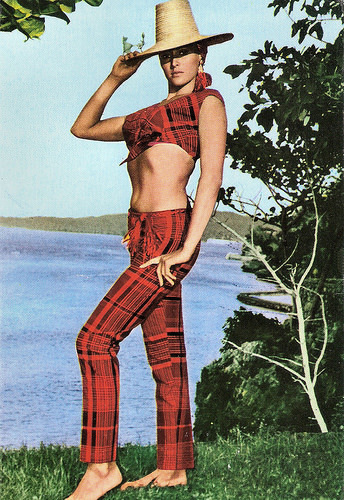
Spanish postcard by Raker, no. 1157, 1965.

Italian postcard, no. 100/110.

Italian postcard, no. 100/111.
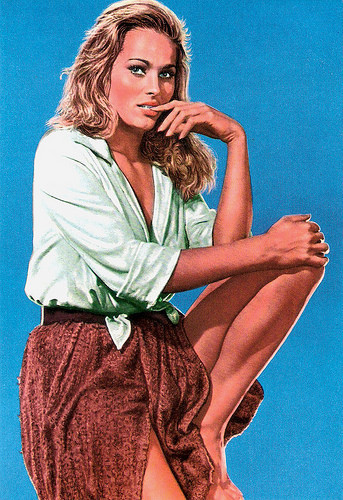
Spanish postcard, no. 240, 1964.
Impressive Physical Attributes
Ursula Andress was born in 1936, in Ostermundigen in the Swiss canton Bern, as one of seven children in a German Protestant family. Her father Rolf Andress was a German diplomat who disappeared during World War II, and her Swiss mother, Anna Andress, was a florist. The third of six children. She has a brother, Arthur and four sisters, Erica, Kàtey, Charlotte and Ruth. She and her siblings were raised by their grandparents. Her younger sister, Kàtey Andress, later unsuccessfully attempted to start a modelling career.
Although often seeming icily aloof, a restless streak early demonstrated itself in her personality, and Andress had a desire from an early age to explore the world outside Switzerland. At 17, she ran away with an Italian actor, then returned home after her mother intervened.
She studied painting, sculpture and dance in Paris. Andress started her career as an art model in Rome, which led to her first roles in the Italian film industry. (Some sources claim that she was on a holiday to Rome at the time). She played small roles in the Italian farces Un americano a Roma/An American in Rome (Steno, 1954), La catena dell'odio/The Chain of Hate (Renato Baldini, 1955) and Le avventure di Giacomo Casanova/Adventures of Giacomo Casanova (Steno, 1955), which focused on her impressive physical attributes.
Eventually, due in part to the patronage of paramour Marlon Brando , she signed a contract with Columbia Pictures and went to Hollywood heralded as the 'New Marlene Dietrich '. Actually the only things she had in common with Dietrich were her (partly) German heritage and her magnificent legs.
In Hollywood she had a troubled relationship with James Dean. One tabloid reported at the time that Dean was learning German so they could "argue in another language". On the day of his death (30 September 1955), Dean asked her to go with him to San Francisco in his Porsche 550 Spyder, but he had to leave Los Angeles without her.
Andress had met actor and pretty-boy John Derek and had fallen in love with him. They married in 1957, and Ursula dropped out of film-making for several years thereafter.
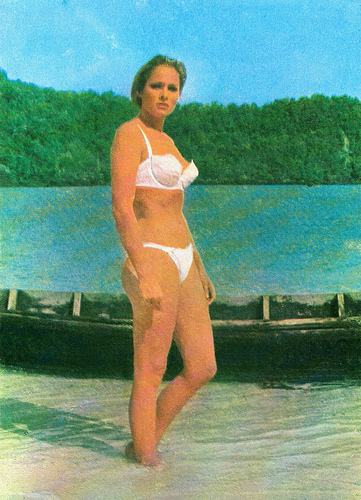
Serbian postcard by Cik Razolednica. Photo: publicity still for Dr. No (1962).
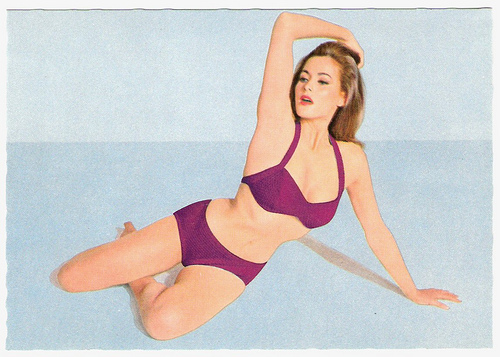
German postcard by ISV, Sort. 12/6.
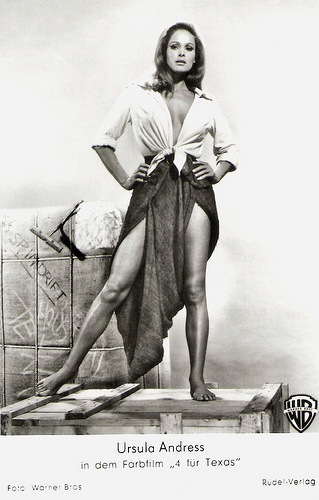
German postcard by Rüdel-Verlag. Photo: Warner Bros. Publicity still for 4 For Texas (Robert Aldrich, 1963).
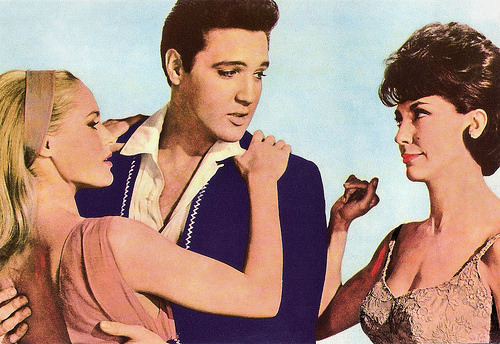
Spanish postcard by Postal Oscarcolor, no. 251. Photo: RCA. Publicity still for Fun in Acapulco (Richard Thorpe, 1963) with Elvis Presley and Elsa Cardenas.
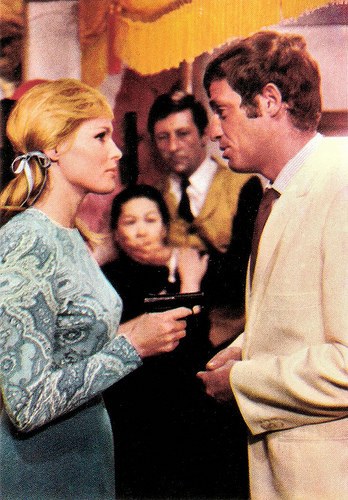
Italian postcard. Photo: Dear Film. Publicity still for Les tribulations d'un Chinois en Chine/Up to His Ears (Philippe de Broca, 1965) with Jean-Paul Belmondo .
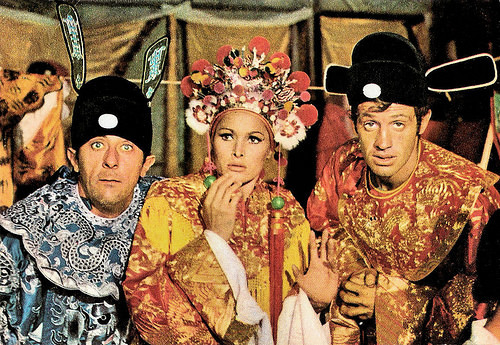
Spanish postcard by Postal Oscarcolor, no. 481. Photo: publicity still for Les tribulations d'un Chinois en Chine/Up to His Ears (Philippe de Broca, 1965) with Jean-Paul Belmondo .
Honey Rider
The year 1962 saw Ursula Andress back on the set, co-starring as Honey Ryder with Sean Connery in the first film version of Ian Fleming's James Bond spy novels, Dr. No (Terence Young, 1962).
On a trip to Greece, John Derek had taken photographs of his wife, and one had been published in a magazine. The photograph was seen by Harry Saltzman, co-producer of the first Bond film, which was scheduled to start shooting within a few weeks even though the female lead had not yet been cast. One glance at the picture was enough. Ursula was offered the part.
Her Swiss/German accent was so strong that her voice had to be dubbed, but Ursula Andress' smouldering-yet-aloof screen presence immediately established her as one of the most desired women in the world. Her performance helped to start the James Bond franchise and set the Bond Girl standard beside which all future Bond actresses would be judged.
In 1964 Andress won even a Golden Globe award for New Star of the Year for her role. The success of Dr. No established Ursula Andress as a spectacular ornament to put on-screen alongside the most bankable talent of the 1960s, and she was cast in Hollywood vehicles for such icons as the 'king of rock 'n' roll', Elvis Presley, in Fun in Acapulco (Richard Thorpe, 1963), and Frank Sinatra in 4 for Texas (Robert Aldrich, 1963).
In Europe she starred with Jean-Paul Belmondo in the Jules Verne adventure Les tribulations d'un chinois en Chine/Up to His Ears (Philippe de Broca, 1965) and with Marcello Mastroianni in the SF thriller La decima vittima/The 10th Victim (Elio Petri, 1965), in which she wears a famously ballistic bra.
She also featured as ‘Ayesha - She who must be obeyed’ in Hammer's fantasy film She (Robert Day, 1965) with Peter Cushing and Christopher Lee . In 1965, she also posed nude for Playboy - the photos were taken by husband John Derek. In The Blue Max (John Guillermin, 1966), she was aptly cast as the sultry, sexually insatiable wife of an aristocratic World War I German general, played by James Mason .
Andress also appeared in the Bond satire Casino Royale (John Huston a.o., 1967) as Vesper Lynd, an occasional spy who persuades Evelyn Tremble (Peter Sellers) to carry out a mission. And she was one of several European starlets to co-star in What's New Pussycat (Clive Donner, Richard Talmadge, 1965) - a film that perhaps sums up mid-196’s pop culture best - written by Woody Allen, starring Allen and Peter Sellers, with music by Burt Bacharach, a title song performed by Tom Jones and much on-screen sexual romping.
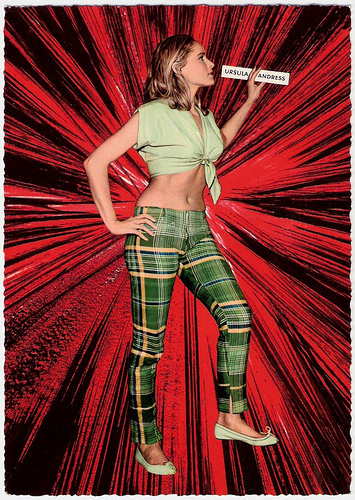
German postcard by Krüger, no. 902/412.
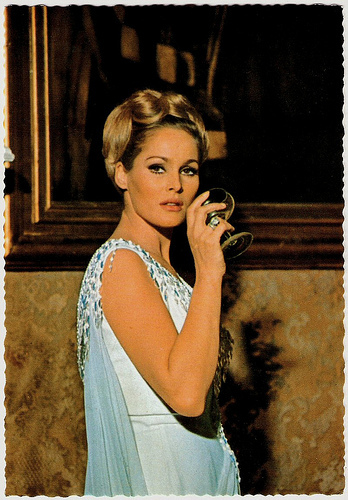
German postcard by ISV, no. H 134.

Belgian postcard by Edt. Decker, Brussels, no. A 113.
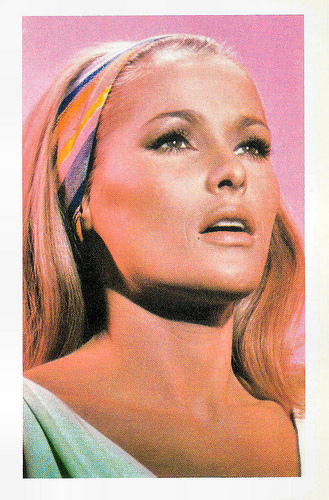
Vintage postcard.
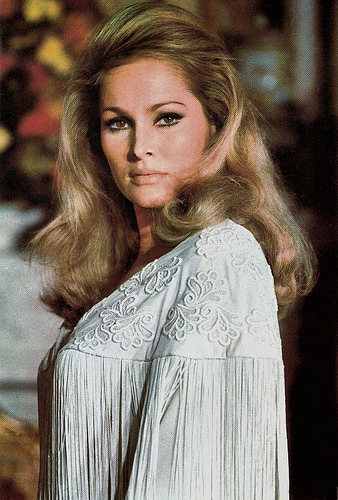
Spanish postcard by Postales Recuadro Blanco Vikingo, Barcelona, no. 441.
Horror in the Jungle
Ursula Andress's charms seemed not to diminish by age. At 40, she could still easily play a bombshell nurse hired to titillate a doddering millionaire to death in the slight Italian sex comedy L'infermiera/The Sensuous Nurse (Nello Rossati, 1975), and three years later she even appeared naked on a stake being rubbed with blood in the ‘horror in the jungle’ exploitation film La montagna del dio cannibale/Slave of the Cannibal God (Sergio Martino, 1978).
Having been divorced by Derek in 1966 so he could pursue younger lookalike Linda Evans, Andress played the field for years, reportedly involved at various times with Jean-Paul Belmondo , Ryan O'Neal, Warren Beatty and Fabio Testi.
In 1979 she began what would be a long-term romance with Harry Hamlin, her handsome young co-star from Clash of the Titans (Desmond Davis, 1981) in which she was cast, predictably, as Aphrodite. In 1980, Andress and Hamlin had a son, Dimitri Hamlin. After her son's birth, Andress scaled back her career.
Andress now focused mostly on European television and films, while she was raising Dimitri in Rome. Among her later films were Krasnye kolokola/Mexico in Flames (Sergei Bondarchuk, 1982) with Franco Nero , Liberté, égalité, choucroute/Liberty, Equality, Sauerkrauten (Jean Yanne, 1985) as Queen Marie Antoinette, and the art film Cremaster 5 (Matthew Barney, 1997).
On television she appeared in the mini-series Peter the Great (Marvin J. Chomsky, Lawrence Schiller, 1986) and in the series Falcon Crest (1988). Most recently she worked on a film in her home country Switzerland. In the satire Die Vogelpredigt/The Bird Preachers (Clemens Klopfenstein, 2005) she appeared as the Virgin Mary.
Her relationship with Harry Hamlin ended in 1982, and since 1983 she has lived with Lorenzo Rispoli. Ostensibly retired from acting, Andress makes the rounds of charity events and pops up on talk shows around Europe every once in a while. She divides her time between family in Switzerland, friends in Spain and Virginia, and her properties in Rome and L.A.
In 2001 the white bikini from Dr. No sold for £35,000 at an auction, in a 2003 Survey by the British Channel 4 her rise from the sea was voted #1 in ‘the 100 Greatest Sexy Moments, and in 2008 the readers of the British newspaper Daily Mail voted her ‘Best Bond Girl of All Time’. Ursula Andress’ performance as Honey Rider has clearly made her an icon of the 20th Century.
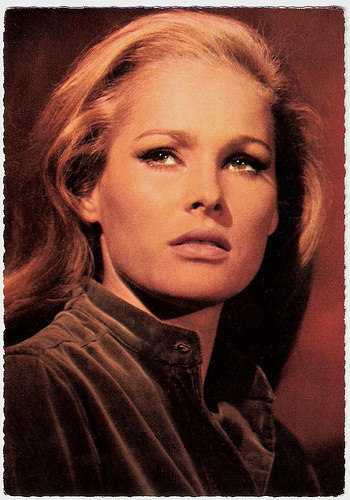
French postcard by E.D.U.G., no. 467.
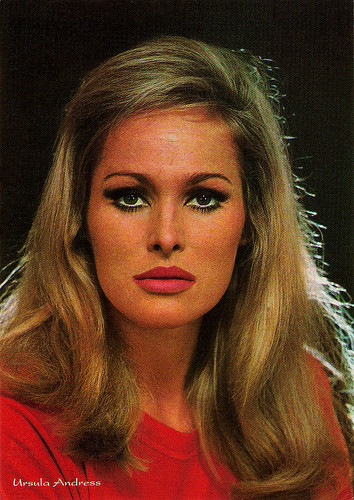
Italian postcard by Rotalfoto, Milano in the Artisti di Sempre series, no. 358.
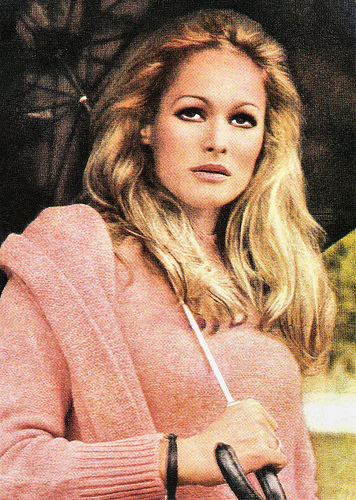
Romanian postcard by Casa Filmului Acin, no. 43078.
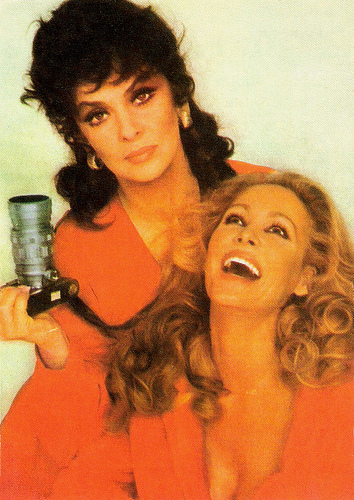
Romanian postcard by Casa Filmului Acin, no. 53189. With Gina Lollobrigida .
Original trailer of Dr. No (1962). Source: ChocolateFrogPrince (YouTube).
Clip from She (1965). Ursula demonstrates why She Must Be Obeyed. Source: DrCForbin (YouTube).
Ursula Andress in L'infermiera (1975). Source: Limesrgreat (YouTube).
Sources: (IMDb), Hal Erickson (AllMovie), Wikipedia, and .

German postcard by Krüger, no. 902/411.

Spanish postcard by Raker, no. 1157, 1965.

Italian postcard, no. 100/110.

Italian postcard, no. 100/111.

Spanish postcard, no. 240, 1964.
Impressive Physical Attributes
Ursula Andress was born in 1936, in Ostermundigen in the Swiss canton Bern, as one of seven children in a German Protestant family. Her father Rolf Andress was a German diplomat who disappeared during World War II, and her Swiss mother, Anna Andress, was a florist. The third of six children. She has a brother, Arthur and four sisters, Erica, Kàtey, Charlotte and Ruth. She and her siblings were raised by their grandparents. Her younger sister, Kàtey Andress, later unsuccessfully attempted to start a modelling career.
Although often seeming icily aloof, a restless streak early demonstrated itself in her personality, and Andress had a desire from an early age to explore the world outside Switzerland. At 17, she ran away with an Italian actor, then returned home after her mother intervened.
She studied painting, sculpture and dance in Paris. Andress started her career as an art model in Rome, which led to her first roles in the Italian film industry. (Some sources claim that she was on a holiday to Rome at the time). She played small roles in the Italian farces Un americano a Roma/An American in Rome (Steno, 1954), La catena dell'odio/The Chain of Hate (Renato Baldini, 1955) and Le avventure di Giacomo Casanova/Adventures of Giacomo Casanova (Steno, 1955), which focused on her impressive physical attributes.
Eventually, due in part to the patronage of paramour Marlon Brando , she signed a contract with Columbia Pictures and went to Hollywood heralded as the 'New Marlene Dietrich '. Actually the only things she had in common with Dietrich were her (partly) German heritage and her magnificent legs.
In Hollywood she had a troubled relationship with James Dean. One tabloid reported at the time that Dean was learning German so they could "argue in another language". On the day of his death (30 September 1955), Dean asked her to go with him to San Francisco in his Porsche 550 Spyder, but he had to leave Los Angeles without her.
Andress had met actor and pretty-boy John Derek and had fallen in love with him. They married in 1957, and Ursula dropped out of film-making for several years thereafter.

Serbian postcard by Cik Razolednica. Photo: publicity still for Dr. No (1962).

German postcard by ISV, Sort. 12/6.

German postcard by Rüdel-Verlag. Photo: Warner Bros. Publicity still for 4 For Texas (Robert Aldrich, 1963).

Spanish postcard by Postal Oscarcolor, no. 251. Photo: RCA. Publicity still for Fun in Acapulco (Richard Thorpe, 1963) with Elvis Presley and Elsa Cardenas.

Italian postcard. Photo: Dear Film. Publicity still for Les tribulations d'un Chinois en Chine/Up to His Ears (Philippe de Broca, 1965) with Jean-Paul Belmondo .

Spanish postcard by Postal Oscarcolor, no. 481. Photo: publicity still for Les tribulations d'un Chinois en Chine/Up to His Ears (Philippe de Broca, 1965) with Jean-Paul Belmondo .
Honey Rider
The year 1962 saw Ursula Andress back on the set, co-starring as Honey Ryder with Sean Connery in the first film version of Ian Fleming's James Bond spy novels, Dr. No (Terence Young, 1962).
On a trip to Greece, John Derek had taken photographs of his wife, and one had been published in a magazine. The photograph was seen by Harry Saltzman, co-producer of the first Bond film, which was scheduled to start shooting within a few weeks even though the female lead had not yet been cast. One glance at the picture was enough. Ursula was offered the part.
Her Swiss/German accent was so strong that her voice had to be dubbed, but Ursula Andress' smouldering-yet-aloof screen presence immediately established her as one of the most desired women in the world. Her performance helped to start the James Bond franchise and set the Bond Girl standard beside which all future Bond actresses would be judged.
In 1964 Andress won even a Golden Globe award for New Star of the Year for her role. The success of Dr. No established Ursula Andress as a spectacular ornament to put on-screen alongside the most bankable talent of the 1960s, and she was cast in Hollywood vehicles for such icons as the 'king of rock 'n' roll', Elvis Presley, in Fun in Acapulco (Richard Thorpe, 1963), and Frank Sinatra in 4 for Texas (Robert Aldrich, 1963).
In Europe she starred with Jean-Paul Belmondo in the Jules Verne adventure Les tribulations d'un chinois en Chine/Up to His Ears (Philippe de Broca, 1965) and with Marcello Mastroianni in the SF thriller La decima vittima/The 10th Victim (Elio Petri, 1965), in which she wears a famously ballistic bra.
She also featured as ‘Ayesha - She who must be obeyed’ in Hammer's fantasy film She (Robert Day, 1965) with Peter Cushing and Christopher Lee . In 1965, she also posed nude for Playboy - the photos were taken by husband John Derek. In The Blue Max (John Guillermin, 1966), she was aptly cast as the sultry, sexually insatiable wife of an aristocratic World War I German general, played by James Mason .
Andress also appeared in the Bond satire Casino Royale (John Huston a.o., 1967) as Vesper Lynd, an occasional spy who persuades Evelyn Tremble (Peter Sellers) to carry out a mission. And she was one of several European starlets to co-star in What's New Pussycat (Clive Donner, Richard Talmadge, 1965) - a film that perhaps sums up mid-196’s pop culture best - written by Woody Allen, starring Allen and Peter Sellers, with music by Burt Bacharach, a title song performed by Tom Jones and much on-screen sexual romping.

German postcard by Krüger, no. 902/412.

German postcard by ISV, no. H 134.

Belgian postcard by Edt. Decker, Brussels, no. A 113.

Vintage postcard.

Spanish postcard by Postales Recuadro Blanco Vikingo, Barcelona, no. 441.
Horror in the Jungle
Ursula Andress's charms seemed not to diminish by age. At 40, she could still easily play a bombshell nurse hired to titillate a doddering millionaire to death in the slight Italian sex comedy L'infermiera/The Sensuous Nurse (Nello Rossati, 1975), and three years later she even appeared naked on a stake being rubbed with blood in the ‘horror in the jungle’ exploitation film La montagna del dio cannibale/Slave of the Cannibal God (Sergio Martino, 1978).
Having been divorced by Derek in 1966 so he could pursue younger lookalike Linda Evans, Andress played the field for years, reportedly involved at various times with Jean-Paul Belmondo , Ryan O'Neal, Warren Beatty and Fabio Testi.
In 1979 she began what would be a long-term romance with Harry Hamlin, her handsome young co-star from Clash of the Titans (Desmond Davis, 1981) in which she was cast, predictably, as Aphrodite. In 1980, Andress and Hamlin had a son, Dimitri Hamlin. After her son's birth, Andress scaled back her career.
Andress now focused mostly on European television and films, while she was raising Dimitri in Rome. Among her later films were Krasnye kolokola/Mexico in Flames (Sergei Bondarchuk, 1982) with Franco Nero , Liberté, égalité, choucroute/Liberty, Equality, Sauerkrauten (Jean Yanne, 1985) as Queen Marie Antoinette, and the art film Cremaster 5 (Matthew Barney, 1997).
On television she appeared in the mini-series Peter the Great (Marvin J. Chomsky, Lawrence Schiller, 1986) and in the series Falcon Crest (1988). Most recently she worked on a film in her home country Switzerland. In the satire Die Vogelpredigt/The Bird Preachers (Clemens Klopfenstein, 2005) she appeared as the Virgin Mary.
Her relationship with Harry Hamlin ended in 1982, and since 1983 she has lived with Lorenzo Rispoli. Ostensibly retired from acting, Andress makes the rounds of charity events and pops up on talk shows around Europe every once in a while. She divides her time between family in Switzerland, friends in Spain and Virginia, and her properties in Rome and L.A.
In 2001 the white bikini from Dr. No sold for £35,000 at an auction, in a 2003 Survey by the British Channel 4 her rise from the sea was voted #1 in ‘the 100 Greatest Sexy Moments, and in 2008 the readers of the British newspaper Daily Mail voted her ‘Best Bond Girl of All Time’. Ursula Andress’ performance as Honey Rider has clearly made her an icon of the 20th Century.

French postcard by E.D.U.G., no. 467.

Italian postcard by Rotalfoto, Milano in the Artisti di Sempre series, no. 358.

Romanian postcard by Casa Filmului Acin, no. 43078.

Romanian postcard by Casa Filmului Acin, no. 53189. With Gina Lollobrigida .
Original trailer of Dr. No (1962). Source: ChocolateFrogPrince (YouTube).
Clip from She (1965). Ursula demonstrates why She Must Be Obeyed. Source: DrCForbin (YouTube).
Ursula Andress in L'infermiera (1975). Source: Limesrgreat (YouTube).
Sources: (IMDb), Hal Erickson (AllMovie), Wikipedia, and .
Published on December 15, 2017 22:00
December 14, 2017
Rotary Photo
The British Rotary Photographic Co. Ltd was active in London between 1897 and 1916. It was a huge publisher of real photographic postcards. Real photographic cards were actual photographs produced from negatives directly onto photographic paper that was postcard sized. Rotary published several elegant postcards of actresses and actors. Its series included the S-series and the Rotary Photographic Series. For this post, we chose 12 delicate portraits of female stars of the British stage and the early British cinema.
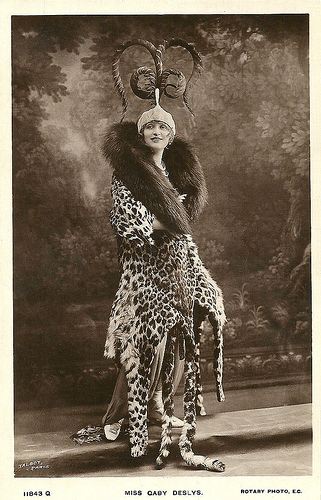
Gaby Deslys . British postcard by Rotary Photo, no. 11843 Q. Photo: Talbot, Paris. Collection: Didier Hanson.
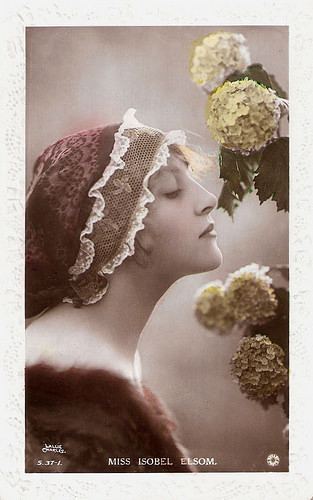
Isobel Elsom . British postcard by Rotary Photo, London, no. S.37-1. Photo: Lallie Charles.
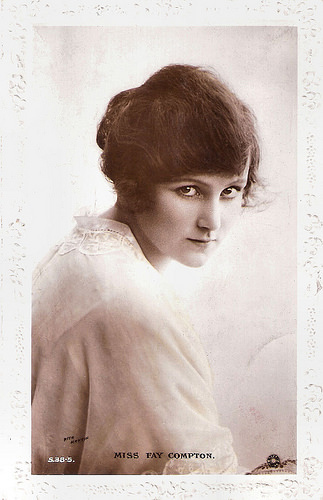
Fay Compton . British postcard by Rotary Photo London, no. S.38-5. Photo: Rita Martin.

Gladys Cooper . British postcard by Rotary Photo, London, no. S.97.3.
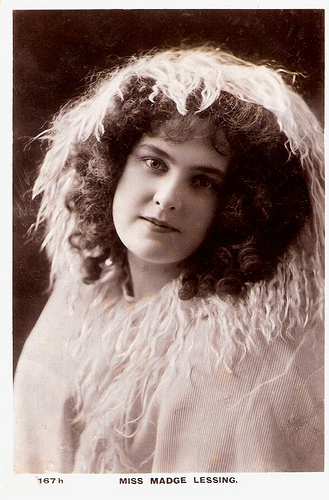
Madge Lessing . British postcard by Rotary, no. 167 h.
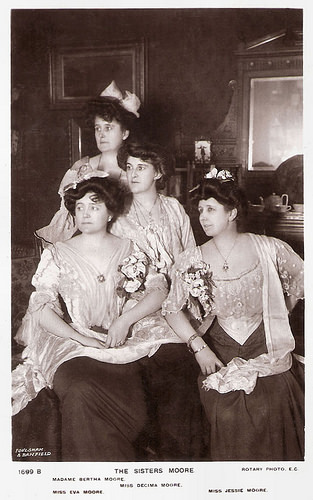
Eva Moore and her sisters Decima, Bertha and Jessie Moore. British postcard in the Rotary Photographic Series, no. 1699 B. Photo: Foulsham & Banfield.
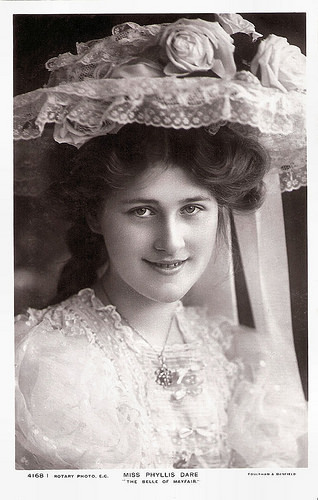
Phyllis Dare . British postcard by Rotary Photo E.C., no. 4168 I. Photo: Foulsham & Banfield. Publicity still for the stage play The Belle of Mayfair (1906).
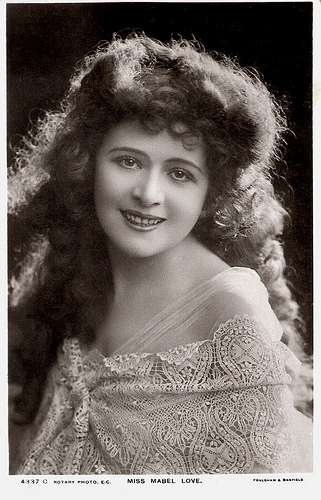
Mabel Love . British postcard by Rotary Photo E.C., no. 4337. Photo: Foulsham & Banfield.
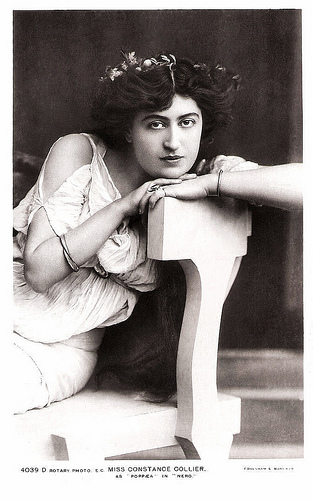
Constance Collier . British postcard by Rotary Photo E.C., no. 4039 D. Photo: Foulsham & Banfield. Publicity still for the stage play Nero (1906) with Constance Collier as Poppaea.
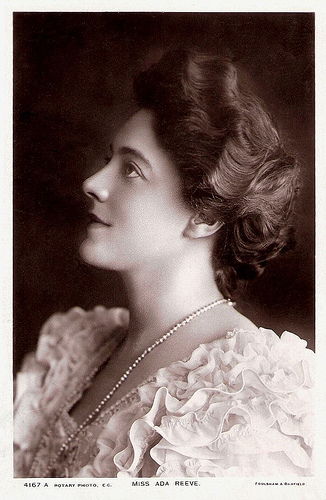
Ada Reeve . British postcard by Rotary Photo E.C., no. 4167 A. Photo: Foulsham & Banfield.
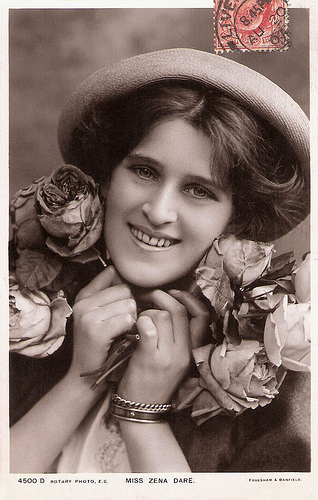
Zena Dare . British postcard by Rotary Photo E.C., no. 4500 D. Photo: Foulsham & Banfield. The postcard was sent by mail in 1907.
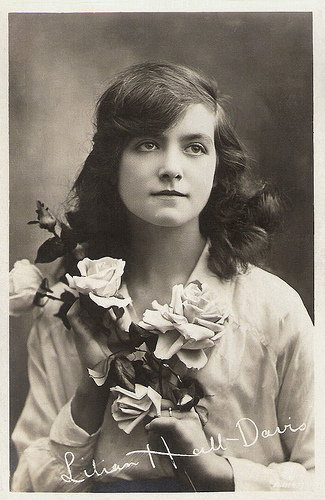
Lilian Hall-Davis . British postcard by Rotary Postcards E.C.
Sources: Grace's Guide, Postcard Collecting, and Ross Postcards.
It is Postcard Friendship Friday, hosted by Beth at the The Best Hearts are Crunchy. You can visit her by clicking on the button below.


Gaby Deslys . British postcard by Rotary Photo, no. 11843 Q. Photo: Talbot, Paris. Collection: Didier Hanson.

Isobel Elsom . British postcard by Rotary Photo, London, no. S.37-1. Photo: Lallie Charles.

Fay Compton . British postcard by Rotary Photo London, no. S.38-5. Photo: Rita Martin.

Gladys Cooper . British postcard by Rotary Photo, London, no. S.97.3.

Madge Lessing . British postcard by Rotary, no. 167 h.

Eva Moore and her sisters Decima, Bertha and Jessie Moore. British postcard in the Rotary Photographic Series, no. 1699 B. Photo: Foulsham & Banfield.

Phyllis Dare . British postcard by Rotary Photo E.C., no. 4168 I. Photo: Foulsham & Banfield. Publicity still for the stage play The Belle of Mayfair (1906).

Mabel Love . British postcard by Rotary Photo E.C., no. 4337. Photo: Foulsham & Banfield.

Constance Collier . British postcard by Rotary Photo E.C., no. 4039 D. Photo: Foulsham & Banfield. Publicity still for the stage play Nero (1906) with Constance Collier as Poppaea.

Ada Reeve . British postcard by Rotary Photo E.C., no. 4167 A. Photo: Foulsham & Banfield.

Zena Dare . British postcard by Rotary Photo E.C., no. 4500 D. Photo: Foulsham & Banfield. The postcard was sent by mail in 1907.

Lilian Hall-Davis . British postcard by Rotary Postcards E.C.
Sources: Grace's Guide, Postcard Collecting, and Ross Postcards.
It is Postcard Friendship Friday, hosted by Beth at the The Best Hearts are Crunchy. You can visit her by clicking on the button below.

Published on December 14, 2017 22:00
December 13, 2017
Ciceruacchio (1915)
During the First World War, several countries started to make propaganda films. In Italy, Tiber Film produced the historical propaganda film Ciceruacchio (Emilio Ghione, 1915).
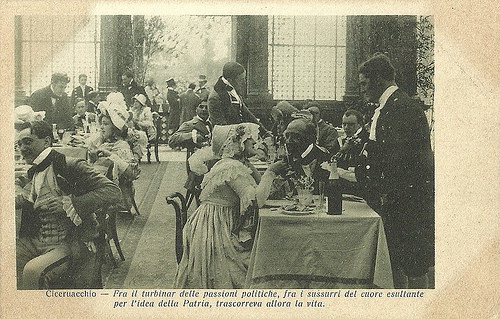
Italian postcard for Ciceruacchio (Emilio Ghione, 1915). Photo: Tiber Film. Caption: Among the turmoil of political passions and among the whispers of a heart overwhelmed by the idea of the Fatherland, he then passed his life.
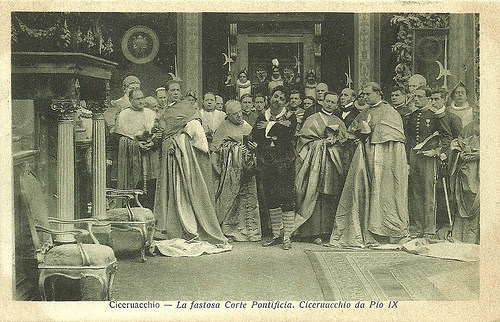
Italian postcard for Ciceruacchio (Emilio Ghione, 1915). Photo: Tiber Film. Caption: The opulent Papal Court. Ciceruacchio (Gastone Monaldi) with Pius IX.
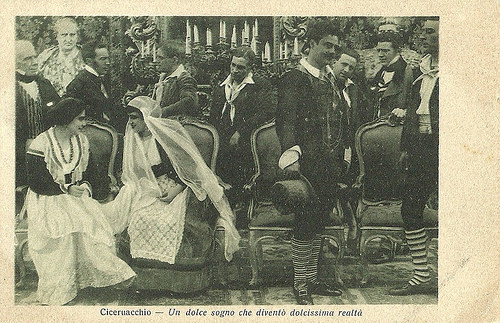
Italian postcard for Ciceruacchio (Emilio Ghione, 1915). Photo: Tiber Film. Caption: A sweet dream that became even sweeter reality.
Intended to raise anti-Austrians sentiment
Ciceruacchio/Martire del piombo austriaco (Martyr of Austrian bullets, 1915) was an Italian historical film by Emilio Ghione , dealing with victims of the Austrian occupation of Italy. The film was intended to raise anti-Austrians sentiment during the First World War when the Northwest part of Italy - the present province of Friuli - was still under Austrian occupation.
Ciceruacchio passed censorship on 22 June 1915, while a week earlier, on 18 June 1915, the film had its first night in Rome. Reputed stage actor Gastone Monaldi, famous for his dialect acting, played the lead of Ciceruacchio, and his partner Fernanda Battiferri played Annetta. Alberto Collo played their son. Ida Carloni Talli played as usual the mother, Brunetti’s mother in this case.
Angelo Brunetti, named Ciceruacchio, a Roman trader in cheese and wine, was much beloved by the Roman people, e.g. for his behaviour during the 1837 cholera plague. In a public performance in 1846 he thanked the pope Pius IX for releasing political prisoners, while in 1847 he pressed Pius IX to continue his policy of reform.
During the 1848 revolution he joined the Roman Republican forces and helped the Romans in the siege by the French. But when they were defeated in 1849, he fled with his sons Lorenzo and Luigi and hoped with Garibaldi and allies to liberate Venice from the Austrians. Instead they were betrayed by locals at Cesenatico and then arrested and executed by the Austrians on 10 August 1849.

Italian postcard for Ciceruacchio (Emilio Ghione, 1915). Photo: Tiber Film. Caption: People of Rome! Do you want to bend to slavery by the stranger? No! Do you want to swear with me to die for freedom? Yes! Yes!
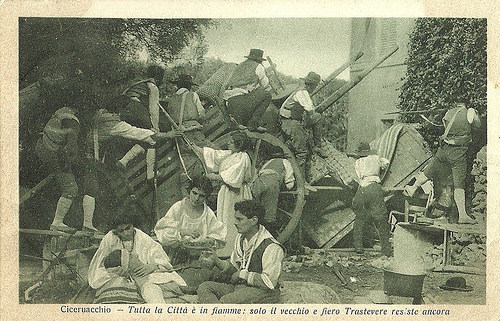
Italian postcard for Ciceruacchio (Emilio Ghione, 1915). Photo: Tiber Film. Caption: The whole city is on fire; only the old and proud Trastevere still resists.
Little fat man
Emilio Ghione was a regular actor for Cines, Celio and Caesar in Rome, before he started to direct films in 1914. For a long time he was most remembered for his Za-la-Mort crime films at Tiber Film, in which he had the lead too. At Tiber he also made various - commissioned - historical propaganda films during the First World War, such as Oberdan (1915) starring Alberto Collo , and Ciceruacchio (1915).
Ciceruacchio (1915) was scripted by Emilio Calve. The plot mostly follows history. The papal police suspects Brunetti, aka Ciceruacchio (meaning little fat man), but when Pius IX hears about Brunetti's bravery during a flood, he gives him a special audience. Brunetti henceforth considers the pope Rome's saviour, while his republican friends think otherwise.
When the pope flees to Gaeta during the revolution, leaving the city to foreign oppressors, Cicueracchio becomes Rome's new leader, but he has to flee after the last stronghold, Trastevere, is conquered. He is betrayed and arrested in Rovigo, and executed with his son Luigi ( Alberto Collo ). In the film, Ghione suggests Brunetti was killed with only his eldest son, while in reality both sons and also several allies of Brunetti were killed with them.
Later, the story of Ciceruacchio would be filmed again in In nome del popolo sovrano (1990) by Luigi Magni, in which Nino Manfredi performed Brunetti. Ciceruacchio was also recreated in Camicie rosse (1952) by Goffredo Alesandrini and Francesco Rosi and returned in the recent mini-series Anita Garibaldi (2012).
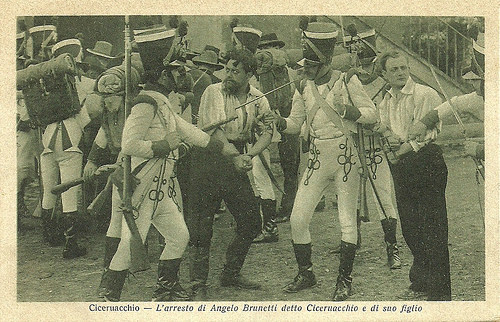
Italian postcard for Ciceruacchio (Emilio Ghione, 1915). Photo: Tiber Film. Caption: The arrest of Angelo Brunetti named Ciceruacchio and his son. Gastone Monaldi as Cicueracchio and Alberto Collo as his son Luigi.
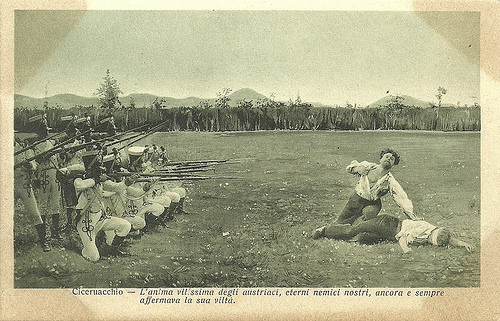
Italian postcard for Ciceruacchio (Emilio Ghione, 1915). Photo: Tiber Film. Caption: The most coward spirit of the Austrians, our eternal enemies, like always and still does confirm its cowardice.
Source: Denis Lotti (Emilio Ghione. L’ ultimo apache - Italian), Wikipedia (Italian) and IMDb.

Italian postcard for Ciceruacchio (Emilio Ghione, 1915). Photo: Tiber Film. Caption: Among the turmoil of political passions and among the whispers of a heart overwhelmed by the idea of the Fatherland, he then passed his life.

Italian postcard for Ciceruacchio (Emilio Ghione, 1915). Photo: Tiber Film. Caption: The opulent Papal Court. Ciceruacchio (Gastone Monaldi) with Pius IX.

Italian postcard for Ciceruacchio (Emilio Ghione, 1915). Photo: Tiber Film. Caption: A sweet dream that became even sweeter reality.
Intended to raise anti-Austrians sentiment
Ciceruacchio/Martire del piombo austriaco (Martyr of Austrian bullets, 1915) was an Italian historical film by Emilio Ghione , dealing with victims of the Austrian occupation of Italy. The film was intended to raise anti-Austrians sentiment during the First World War when the Northwest part of Italy - the present province of Friuli - was still under Austrian occupation.
Ciceruacchio passed censorship on 22 June 1915, while a week earlier, on 18 June 1915, the film had its first night in Rome. Reputed stage actor Gastone Monaldi, famous for his dialect acting, played the lead of Ciceruacchio, and his partner Fernanda Battiferri played Annetta. Alberto Collo played their son. Ida Carloni Talli played as usual the mother, Brunetti’s mother in this case.
Angelo Brunetti, named Ciceruacchio, a Roman trader in cheese and wine, was much beloved by the Roman people, e.g. for his behaviour during the 1837 cholera plague. In a public performance in 1846 he thanked the pope Pius IX for releasing political prisoners, while in 1847 he pressed Pius IX to continue his policy of reform.
During the 1848 revolution he joined the Roman Republican forces and helped the Romans in the siege by the French. But when they were defeated in 1849, he fled with his sons Lorenzo and Luigi and hoped with Garibaldi and allies to liberate Venice from the Austrians. Instead they were betrayed by locals at Cesenatico and then arrested and executed by the Austrians on 10 August 1849.

Italian postcard for Ciceruacchio (Emilio Ghione, 1915). Photo: Tiber Film. Caption: People of Rome! Do you want to bend to slavery by the stranger? No! Do you want to swear with me to die for freedom? Yes! Yes!

Italian postcard for Ciceruacchio (Emilio Ghione, 1915). Photo: Tiber Film. Caption: The whole city is on fire; only the old and proud Trastevere still resists.
Little fat man
Emilio Ghione was a regular actor for Cines, Celio and Caesar in Rome, before he started to direct films in 1914. For a long time he was most remembered for his Za-la-Mort crime films at Tiber Film, in which he had the lead too. At Tiber he also made various - commissioned - historical propaganda films during the First World War, such as Oberdan (1915) starring Alberto Collo , and Ciceruacchio (1915).
Ciceruacchio (1915) was scripted by Emilio Calve. The plot mostly follows history. The papal police suspects Brunetti, aka Ciceruacchio (meaning little fat man), but when Pius IX hears about Brunetti's bravery during a flood, he gives him a special audience. Brunetti henceforth considers the pope Rome's saviour, while his republican friends think otherwise.
When the pope flees to Gaeta during the revolution, leaving the city to foreign oppressors, Cicueracchio becomes Rome's new leader, but he has to flee after the last stronghold, Trastevere, is conquered. He is betrayed and arrested in Rovigo, and executed with his son Luigi ( Alberto Collo ). In the film, Ghione suggests Brunetti was killed with only his eldest son, while in reality both sons and also several allies of Brunetti were killed with them.
Later, the story of Ciceruacchio would be filmed again in In nome del popolo sovrano (1990) by Luigi Magni, in which Nino Manfredi performed Brunetti. Ciceruacchio was also recreated in Camicie rosse (1952) by Goffredo Alesandrini and Francesco Rosi and returned in the recent mini-series Anita Garibaldi (2012).

Italian postcard for Ciceruacchio (Emilio Ghione, 1915). Photo: Tiber Film. Caption: The arrest of Angelo Brunetti named Ciceruacchio and his son. Gastone Monaldi as Cicueracchio and Alberto Collo as his son Luigi.

Italian postcard for Ciceruacchio (Emilio Ghione, 1915). Photo: Tiber Film. Caption: The most coward spirit of the Austrians, our eternal enemies, like always and still does confirm its cowardice.
Source: Denis Lotti (Emilio Ghione. L’ ultimo apache - Italian), Wikipedia (Italian) and IMDb.
Published on December 13, 2017 22:00
December 12, 2017
Suzanna Leigh (1945-2017)
On 11 December 2017, blonde British actress Suzanna Leigh (1945-2017) passed away. She was known for her film and television roles in the 1960s and 1970s, including Hammer horror films and a Hawaii musical with Elvis Presley.
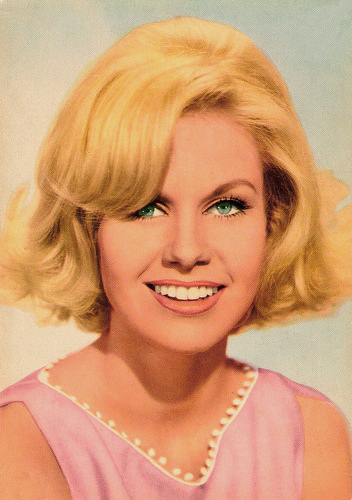
Spanish postcard by Postal Oscar Color S.A., Hospitalet (Barcelona), no. 592.
Costumed as Madame Du Barry
Suzanna Leigh was born Sandra Eileen Anne Smith in 1945 in Belgrave (some sources say Berkshire), England. Her father was an auto engine manufacturer and professional gambler. Her mother’s a millionaire property developer. Her father died when she was six.
Leigh grew up in Berkshire (some sources say Belgravia, London), and later went to convent schools outside London. She began working in films while still a child, appearing as an extra in British productions. These included the romantic comedy The Silken Affair (Roy Kellino, 1956) starring David Niven and Geneviève Page , and the fantasy-musical Tom Thumb (George Pal, 1958). 7
She changed her name to Suzanna Leigh after entering film, after actress Vivien Leigh . A few years later, she was the star of the 13-episode French TV series, Trois étoiles en Touraine (Maurice Régamey, 1966), which every week featured Leigh, her racing car and a different male lead.
Planning to attend London's Opera Ball, costumed as Madame Du Barry, Leigh had a sedan chair made, along with costumes for five footmen who carried it (and her) through the streets of the city. American producer Hal B. Wallis saw newspaper photos of Leigh's elaborate stunt and imported the 20-year-old blonde to Hollywood.
Leigh's American film roles included a stewardess in the American bedroom farce Boeing Boeing (John Rich, 1965) starring Jerry Lewis and Tony Curtis, and the love interest of Elvis Presley in Paradise, Hawaiian Style (Michael D. Moore, 1966). In 1966 her US career hit a snag when the Hollywood and English acting guilds got into a tangle, and she returned to England.
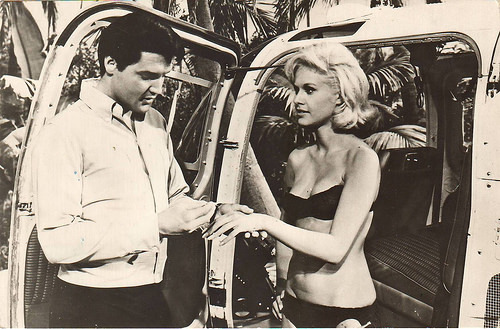
Romanian postcard by Casa Filmului Acin. Photo: publicity still for Paradise, Hawaiian Style (Michael D. Moore, 1966) with Elvis Presley and Suzanna Leigh. Collection: Veronique3.
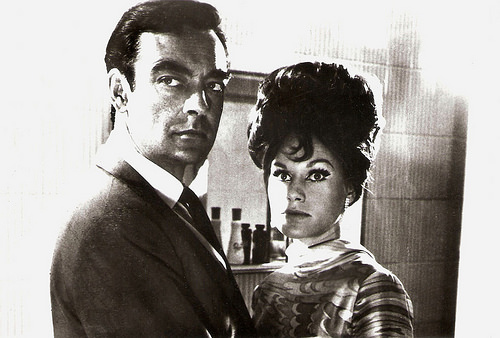
Romanian postcard by Casa Filmului Acin. Photo: publicity still for Deadlier than the male (Ralph Thomas, 1967) with Richard Johnson and Suzanna Leigh.
The Kate Winslet of her Day
Back in England, Suzanna Leigh became the frail heroine in a couple of Hammer films such as The Lost Continent (Michael Carreras, 1968) with Eric Porter and Hildegard Knef, and Lust for a Vampire (Jimmy Sangster, 1971).
She also starred in the cult horror films The Deadly Bees (Freddie Francis, 1966) and The Fiend (Robert Hartford-Davis, 1972) with Ann Todd . In 1974 she starred as Amber in the musical comedy Son of Dracula (Freddie Francis, 1974) starring Harry Nilsson and Ringo Starr .
Hester Lacey called Leigh in The Independent "the Kate Winslet of her day: a beautiful, feted young British actress who made it big in Hollywood. She lived a champagne lifestyle, mixed with the beautiful people and drove a Rolls Royce. She was presented to the Queen at a Royal Command Performance."
She met Tim Hue-Williams, to be the father of her daughter, Natalia, at Ascot in 1972. This led to a 10-year relationship which ended when Hue-Williams deserted her for a rich heiress, his best friend's fiancee, when Leigh was four months pregnant.
Her heydays were over and after a long and painful divorce, she retired to a small rented flat in a London suburb, with her daughter Natalia and her sheltie dog Sukie. She worked as an interior designer, gave etiquette lessons and sold the Encyclopedia Britannica at Heathrow Airport.
In 2000, she published the autobiography, Paradise, Suzanna Style. In 2015, she was a featured player in the American film, Grace of the Father (De Miller, 2015).
In September 2016, Suzanna Leigh was diagnosed with ‘stage-four’ liver cancer and she died on 11 December 2017.
Trailer Boeing Boeing (1965). Source: Classic Airliners & Vintage Pop Culture (YouTube).
Trailer Lust for a Vampire (1971). Source: kaijindaigo (YouTube).
Sources: Hester Lacey (The Independent), (IMDb), Glamour Girls of the Silver Screen, Wikipedia and .

Spanish postcard by Postal Oscar Color S.A., Hospitalet (Barcelona), no. 592.
Costumed as Madame Du Barry
Suzanna Leigh was born Sandra Eileen Anne Smith in 1945 in Belgrave (some sources say Berkshire), England. Her father was an auto engine manufacturer and professional gambler. Her mother’s a millionaire property developer. Her father died when she was six.
Leigh grew up in Berkshire (some sources say Belgravia, London), and later went to convent schools outside London. She began working in films while still a child, appearing as an extra in British productions. These included the romantic comedy The Silken Affair (Roy Kellino, 1956) starring David Niven and Geneviève Page , and the fantasy-musical Tom Thumb (George Pal, 1958). 7
She changed her name to Suzanna Leigh after entering film, after actress Vivien Leigh . A few years later, she was the star of the 13-episode French TV series, Trois étoiles en Touraine (Maurice Régamey, 1966), which every week featured Leigh, her racing car and a different male lead.
Planning to attend London's Opera Ball, costumed as Madame Du Barry, Leigh had a sedan chair made, along with costumes for five footmen who carried it (and her) through the streets of the city. American producer Hal B. Wallis saw newspaper photos of Leigh's elaborate stunt and imported the 20-year-old blonde to Hollywood.
Leigh's American film roles included a stewardess in the American bedroom farce Boeing Boeing (John Rich, 1965) starring Jerry Lewis and Tony Curtis, and the love interest of Elvis Presley in Paradise, Hawaiian Style (Michael D. Moore, 1966). In 1966 her US career hit a snag when the Hollywood and English acting guilds got into a tangle, and she returned to England.

Romanian postcard by Casa Filmului Acin. Photo: publicity still for Paradise, Hawaiian Style (Michael D. Moore, 1966) with Elvis Presley and Suzanna Leigh. Collection: Veronique3.

Romanian postcard by Casa Filmului Acin. Photo: publicity still for Deadlier than the male (Ralph Thomas, 1967) with Richard Johnson and Suzanna Leigh.
The Kate Winslet of her Day
Back in England, Suzanna Leigh became the frail heroine in a couple of Hammer films such as The Lost Continent (Michael Carreras, 1968) with Eric Porter and Hildegard Knef, and Lust for a Vampire (Jimmy Sangster, 1971).
She also starred in the cult horror films The Deadly Bees (Freddie Francis, 1966) and The Fiend (Robert Hartford-Davis, 1972) with Ann Todd . In 1974 she starred as Amber in the musical comedy Son of Dracula (Freddie Francis, 1974) starring Harry Nilsson and Ringo Starr .
Hester Lacey called Leigh in The Independent "the Kate Winslet of her day: a beautiful, feted young British actress who made it big in Hollywood. She lived a champagne lifestyle, mixed with the beautiful people and drove a Rolls Royce. She was presented to the Queen at a Royal Command Performance."
She met Tim Hue-Williams, to be the father of her daughter, Natalia, at Ascot in 1972. This led to a 10-year relationship which ended when Hue-Williams deserted her for a rich heiress, his best friend's fiancee, when Leigh was four months pregnant.
Her heydays were over and after a long and painful divorce, she retired to a small rented flat in a London suburb, with her daughter Natalia and her sheltie dog Sukie. She worked as an interior designer, gave etiquette lessons and sold the Encyclopedia Britannica at Heathrow Airport.
In 2000, she published the autobiography, Paradise, Suzanna Style. In 2015, she was a featured player in the American film, Grace of the Father (De Miller, 2015).
In September 2016, Suzanna Leigh was diagnosed with ‘stage-four’ liver cancer and she died on 11 December 2017.
Trailer Boeing Boeing (1965). Source: Classic Airliners & Vintage Pop Culture (YouTube).
Trailer Lust for a Vampire (1971). Source: kaijindaigo (YouTube).
Sources: Hester Lacey (The Independent), (IMDb), Glamour Girls of the Silver Screen, Wikipedia and .
Published on December 12, 2017 22:00
December 11, 2017
Hermann Brix
Hermann Brix (1912-1982) was an Austrian actor and theatre and radio play author. Between 1939 and 1944 he starred in many Terra films. He should not be confused with the American actor Herman Brix (a.k.a. Bruce Bennett).
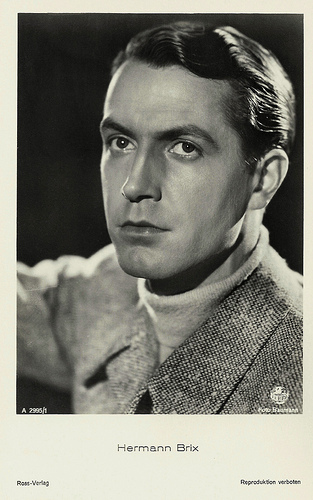
German postcard by Ross Verlag, no. A 2995/1, 1939-1940. Photo: Baumann / Terra.
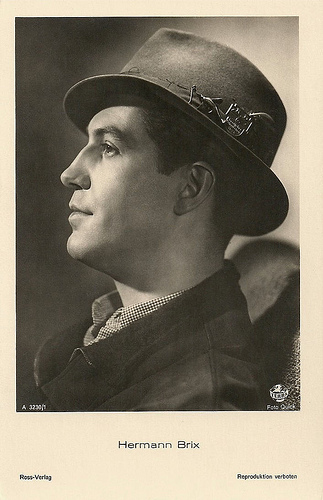
German postcard by Ross Verlag, no. A 3230/1, 1941-1944. Photo: Quick / Terra Film.
Unknown Mother
Hermann Brix was born in Innsbruck, Austria (then Austria-Hungary) in 1912. He studied German and medicine first, took acting lessons after that, and in 1936 he debuted on stage in Prague. Later he got an engagement at the Münchner Kammerspiele in Munich.
Brix became well-known as a film actor in German cinema during the war years, mostly at Terra-Filmkunst. He probably started his film career in the Terra-production Opernball/Opera Ball (Géza von Bolváry, 1939) with Paul Hörbiger .
This first film appearance was soon followed by Maria Ilona (Géza von Bolváry, 1939) in which he played Emperor Franz Joseph opposite Paula Wessely. After the premiere of tis film in Vienna, he signed a contract with Terra Film in Berlin.
For Terra, Brix appeared in such films as Die guten Sieben/The Lucky Seven (Wolfgang Liebeneier, 1940) starring Johannes Riemann , and Alarm auf Station III/Alarm on station III (Philipp Lothar Mayring, 1939) starring Gustav Fröhlich .
Slowly, his parts became bigger as in Falschmünzer/Forger (Hermann Pfeiffer, 1940), Der Herr im Haus/The Landlord (Heinz Helbig, 1940) starring Hans Moser , Sein Sohn/His Son (Peter Paul Breuer, 1941), and Dreimal Hochzeit/Three times wedding (Géza von Bolváry, 1941) with Marte Harell and Willy Fritsch .
Brix had his first lead in Die Kelnerin Anna/The Waitress Anna (Peter Paul Breuer, 1941) as a young music student in Salzburg, who doesn’t know that the local waitress (Franziska Kinz) who takes so much care of him is his mother.
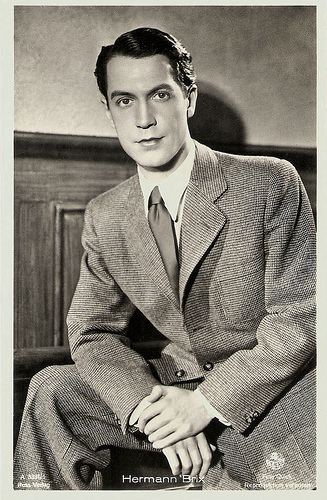
German postcard by Ross Verlag, no A 3331/1, 1941-1944. Photo: Quick / Terra.
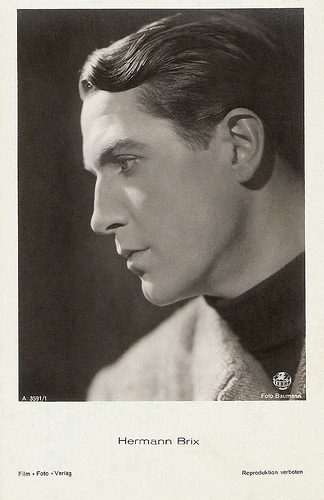
German postcard by Film-Foto-Verlag, no. A 3591/1, 1941-1944. Photo: Baumann / Terra.
Titanic
Hermann Brix played a band leader in the disaster drama Titanic (Herbert Selpin, 1943), and a police commissioner in the spy story Die goldene Spinne/The Golden Spider (Erich Engels, 1943).
He appeared as Eva Maria Meineke’s lover in the comedy Moselfahrt mit Monika/A Trip on the Mosel with Monika (Roger von Norman, 1944). The film was completed in 1944, but submitted to Filmprüfstelle in October 1944, and it was eventually released in 1952.
His last wartime performance was in the romantic comedy Der Meisterdetektiv/The master detective (Hubert Marischka, 1944) with Georg Alexander .
After the war Brix worked only twice as a film actor. In 1947 he appeared in the French-Austrian comedy Les amours de Blanche Neige/The Loves of Snowwhite (Edi Wieser, 1947). Three years later he played the lead in the comedy Die Erbschaft aus Amerika/Luck from Ohio (Heinz Paul, 1950).
Rudi Polt at IMDb suggests that Brix was more interested in stage theatre and radio. He returned to his birth town Innsbrück where he wrote stage and radio plays.
From 1966 on he taught drama at the Universität Innsbruck and was manager of the Studiobühne. Among his pupils were Dietmar Schönherr , Axel Corti, and Volkmar Parschalk. He also directed several plays at the Tiroler Landestheater.
Hermann Brix died in Innsbruck in 1982. He was 70.
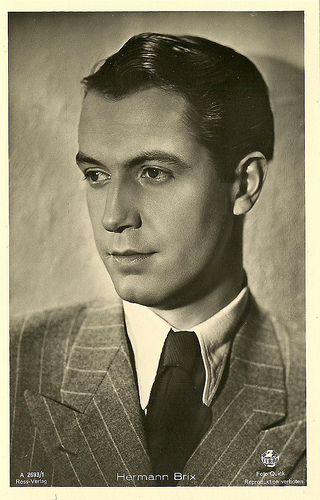
German postcard by Ross Verlag, no. A 2693/1, 1941-1944. Photo: Quick/Terra. Collection: Didier Hanson.
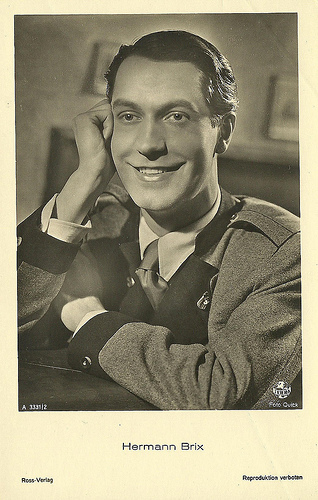
German postcard by Ross Verlag, no. A 3331/2, 1941-1944. Photo: Quick/Terra. Collection: Didier Hanson.
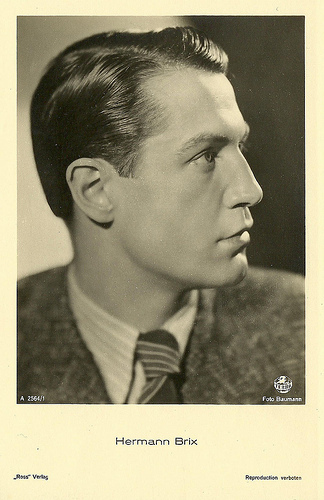
German postcard by Ross Verlag, no. A 2564/1, 1941-1944. Photo: Baumann/Terra. Collection: Didier Hanson.
Sources: (IMDb), Thomas Staedeli (Cyranos), Filmportal.de, Wikipedia (German) and .

German postcard by Ross Verlag, no. A 2995/1, 1939-1940. Photo: Baumann / Terra.

German postcard by Ross Verlag, no. A 3230/1, 1941-1944. Photo: Quick / Terra Film.
Unknown Mother
Hermann Brix was born in Innsbruck, Austria (then Austria-Hungary) in 1912. He studied German and medicine first, took acting lessons after that, and in 1936 he debuted on stage in Prague. Later he got an engagement at the Münchner Kammerspiele in Munich.
Brix became well-known as a film actor in German cinema during the war years, mostly at Terra-Filmkunst. He probably started his film career in the Terra-production Opernball/Opera Ball (Géza von Bolváry, 1939) with Paul Hörbiger .
This first film appearance was soon followed by Maria Ilona (Géza von Bolváry, 1939) in which he played Emperor Franz Joseph opposite Paula Wessely. After the premiere of tis film in Vienna, he signed a contract with Terra Film in Berlin.
For Terra, Brix appeared in such films as Die guten Sieben/The Lucky Seven (Wolfgang Liebeneier, 1940) starring Johannes Riemann , and Alarm auf Station III/Alarm on station III (Philipp Lothar Mayring, 1939) starring Gustav Fröhlich .
Slowly, his parts became bigger as in Falschmünzer/Forger (Hermann Pfeiffer, 1940), Der Herr im Haus/The Landlord (Heinz Helbig, 1940) starring Hans Moser , Sein Sohn/His Son (Peter Paul Breuer, 1941), and Dreimal Hochzeit/Three times wedding (Géza von Bolváry, 1941) with Marte Harell and Willy Fritsch .
Brix had his first lead in Die Kelnerin Anna/The Waitress Anna (Peter Paul Breuer, 1941) as a young music student in Salzburg, who doesn’t know that the local waitress (Franziska Kinz) who takes so much care of him is his mother.

German postcard by Ross Verlag, no A 3331/1, 1941-1944. Photo: Quick / Terra.

German postcard by Film-Foto-Verlag, no. A 3591/1, 1941-1944. Photo: Baumann / Terra.
Titanic
Hermann Brix played a band leader in the disaster drama Titanic (Herbert Selpin, 1943), and a police commissioner in the spy story Die goldene Spinne/The Golden Spider (Erich Engels, 1943).
He appeared as Eva Maria Meineke’s lover in the comedy Moselfahrt mit Monika/A Trip on the Mosel with Monika (Roger von Norman, 1944). The film was completed in 1944, but submitted to Filmprüfstelle in October 1944, and it was eventually released in 1952.
His last wartime performance was in the romantic comedy Der Meisterdetektiv/The master detective (Hubert Marischka, 1944) with Georg Alexander .
After the war Brix worked only twice as a film actor. In 1947 he appeared in the French-Austrian comedy Les amours de Blanche Neige/The Loves of Snowwhite (Edi Wieser, 1947). Three years later he played the lead in the comedy Die Erbschaft aus Amerika/Luck from Ohio (Heinz Paul, 1950).
Rudi Polt at IMDb suggests that Brix was more interested in stage theatre and radio. He returned to his birth town Innsbrück where he wrote stage and radio plays.
From 1966 on he taught drama at the Universität Innsbruck and was manager of the Studiobühne. Among his pupils were Dietmar Schönherr , Axel Corti, and Volkmar Parschalk. He also directed several plays at the Tiroler Landestheater.
Hermann Brix died in Innsbruck in 1982. He was 70.

German postcard by Ross Verlag, no. A 2693/1, 1941-1944. Photo: Quick/Terra. Collection: Didier Hanson.

German postcard by Ross Verlag, no. A 3331/2, 1941-1944. Photo: Quick/Terra. Collection: Didier Hanson.

German postcard by Ross Verlag, no. A 2564/1, 1941-1944. Photo: Baumann/Terra. Collection: Didier Hanson.
Sources: (IMDb), Thomas Staedeli (Cyranos), Filmportal.de, Wikipedia (German) and .
Published on December 11, 2017 22:00
December 10, 2017
Alla Larionova
Beautiful Russian stage and film actress Alla Larionova (1931-2000) was one of the most popular stars of the Soviet cinema of the 1950s. She was known for such films as the Fairy-tale Sadko (1952), Anna na shee (1954) and Trizhdy voskresshiy (1960).
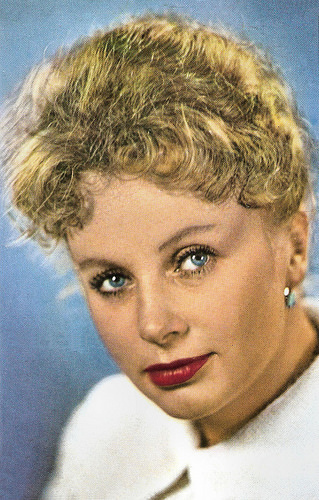
Russian postcard, no. A 09462, 1965. Photo: G. Ter-Ovanesova.
A Forbidden Beautiful World
Alla Dmitrievna Larionova was born in Moscow, USSR (now Russia) in 1931. Her father was an employee of a food store, and her mother worked as a keeper in a kindergarten. Her parents named her after the film star Alla Tarasova, and thus programmed their little daughter for the future.
After her father went to the front, Alla and her mother evacuated to Menzelinsk, where her mother worked in a hospital. Here, 9-year-old Alla Larionova appeared for the first time on stage. She read poetry to the wounded in the hospital.
When she was barely 15 years old, the young and charming Alla was discovered for the cinema. An unfamiliar woman approached her on the street, and asked if the girl wanted to act in films. Of course, Larionova wanted and appeared in a small part in the biographical drama Michurin (Aleksandr Dovzhenko, 1949), featuring Grigori Belov.
After graduation, Alla went to study as an actress at the Lunacharsky State Institute for Theatre Arts (GITIS) in Moscow. In 1948, she continued her studies at the Gerasimov Institute of Cinematography (VGIK), where she met her future husband Nikolai Rybnikov. At the GITIS, she failed miserably at her exams. Before her examiners, she saw the famous director Vasily Mikhailovich Goncharov and got a black-out.
However, during her study years, she got a star-making role, which determined her entire career in the cinema. She played Lyubava in Sadko (Aleksandr Ptushko, 1952) with Sergei Stolyarov. The Fairy-tale film was so successful that the following year the film was invited to Venice Film Festival, where it won the Silver Lion.
This success meant an international breakthrough for the Soviet cinema. In Venice, the beautiful Larionova was followed by crowds of journalists and admirers ran. Well-known producers and directors, including Charles Chaplin , offered her roles that she flatly refused. As the Russian website 24smi writes: “official representatives, officials who accompanied a group of artists abroad, were strictly forbidden to go to contacts with ‘bourgeois’ directors.” Larionova returned home from Italy in tears. She had been allowed to touch a beautiful world, to see it, but was forbidden to live in it.
Back home, she was offered the leading role in Anna na shee/The Anna Cross (Isidor Annensky, 1954), based on a short story by Anton Chekhov. The film turned Larionova into a big star of the Soviet cinema. Hundreds of people, often in bad weather, stood in queues in front of cinemas to see the film. After the actress starred as the beautiful Olivia in Dvenadtsataya noch/Twelfth Night (A. Abramov, Yan Frid, 1955), fans followed her to the studio and her apartment, looked in windows and waited for her exit. Even the minister of culture came to see the actress.
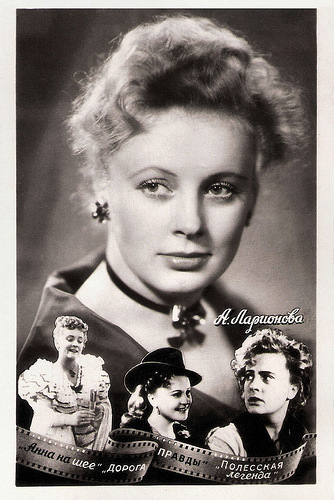
Russian postcard, no. AB13758, 1958. Photo: V. Kačna.
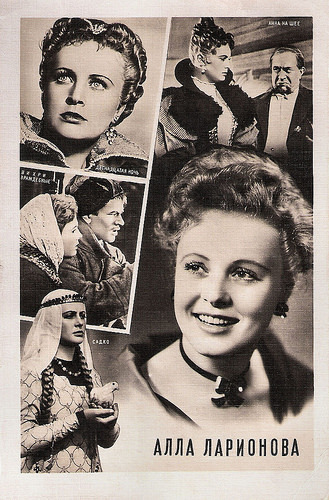
Russian multiview postcard, no. 1446, 1963. Included are scene photos from Sadko (1952), Vikhri vrazhdebnye/Hostile Whirlwinds (Mikhail Kalatozov, 1953), Anna na shee (1954), and Dvenadtsataya noch/Twelfth Night (A. Abramov, Yan Frid, 1955).
Hindered by the officials
Curiously, Alla Larionova was not offered any more leading roles and her career seemed to be hindered by officials. For example for the film Ilya Muromets/The Sword and the Dragon (Aleksandr Ptushko, 1956), Larionova was not allowed to travel to Yalta, where the shooting of the film took place.
Her few leading roles in the following years included Sudba barabanshchika/The Drummer's Fate (Viktor Eisymont, 1956), the romance Mlechnyy Put/Milky Way (Isaak Shmaruk, 1959) and Trizhdy voskresshiy/Thrice Resurrected (Leonid Gayday, 1960).
During the 1960s and 1970s, Alla Larionova never got leading roles. When the beautiful actress starred in a film it was in ‘ugly’ roles, such as in Dikiy myod/Wild Honey (Vladimir Chebotaryov, 1967), where her face was smeared with mud.
Larionova proved that she could play character roles very well. She played Natalia Dmitrievna Paskudin in the Anton Chekhov adaptation Tri sestry/The Three Sisters (Samson Samsonov, 1964), Donesova in Ko mne, Mukhtar!/Come Here, Mukhtar! (Semyon Tumanov, 1965), Elena Ivanovna in Fokusnik/The Magician (Pyotr Todorovskiy, 1967) and Ekaterina II in the family comedy Yest ideya!/There is an idea! (Vladimir Bychkov, 1977).
But the kind of roles that had made her famous, she was not offered anymore. When she turned 60, Alla Larionova was given the title People's Artist of the RSFSR in 1990, but no significant roles followed anymore. Russian Wikipedia suggests the reason was a scar in her face caused by an accident. Actor George Yumatov, in a state of intoxication, had decided to take Alla Larionova home and caused the accident at which she hit her head and cut her lip. After that, she ceased to appear in films, since the scar was too noticeable.
Larionova lived very quietly and modestly. She travelled around the country with the theatre group named after Eugene Vakhtangov. She was married to Nikolai Rybnikov from 1957 till his death in 1990. Shortly after their marriage was registered, she gave birth to her daughter Alena from actor Ivan Pereverzev. In 1961, their second daughter Arina was born. Alla Larionova died from a heart attack in 2000 in Moscow, Russia. She was buried next to her husband at the Troekurovsky cemetery. In 2004, their daughter Arina, addicted to alcohol, died.
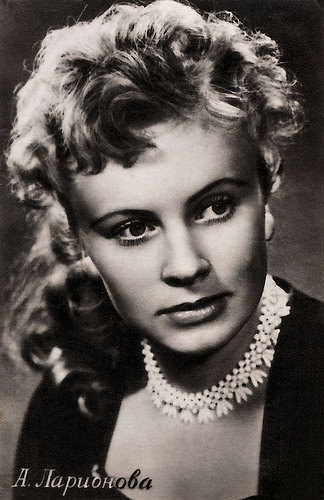
Small Russian collectors card.
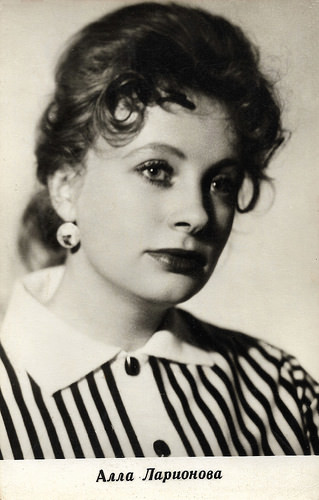
Russian postcard, no. A-06650. Photo: G. Vajlja.
Sources: 24 smi (Russian), Wikipedia (Russian) and .

Russian postcard, no. A 09462, 1965. Photo: G. Ter-Ovanesova.
A Forbidden Beautiful World
Alla Dmitrievna Larionova was born in Moscow, USSR (now Russia) in 1931. Her father was an employee of a food store, and her mother worked as a keeper in a kindergarten. Her parents named her after the film star Alla Tarasova, and thus programmed their little daughter for the future.
After her father went to the front, Alla and her mother evacuated to Menzelinsk, where her mother worked in a hospital. Here, 9-year-old Alla Larionova appeared for the first time on stage. She read poetry to the wounded in the hospital.
When she was barely 15 years old, the young and charming Alla was discovered for the cinema. An unfamiliar woman approached her on the street, and asked if the girl wanted to act in films. Of course, Larionova wanted and appeared in a small part in the biographical drama Michurin (Aleksandr Dovzhenko, 1949), featuring Grigori Belov.
After graduation, Alla went to study as an actress at the Lunacharsky State Institute for Theatre Arts (GITIS) in Moscow. In 1948, she continued her studies at the Gerasimov Institute of Cinematography (VGIK), where she met her future husband Nikolai Rybnikov. At the GITIS, she failed miserably at her exams. Before her examiners, she saw the famous director Vasily Mikhailovich Goncharov and got a black-out.
However, during her study years, she got a star-making role, which determined her entire career in the cinema. She played Lyubava in Sadko (Aleksandr Ptushko, 1952) with Sergei Stolyarov. The Fairy-tale film was so successful that the following year the film was invited to Venice Film Festival, where it won the Silver Lion.
This success meant an international breakthrough for the Soviet cinema. In Venice, the beautiful Larionova was followed by crowds of journalists and admirers ran. Well-known producers and directors, including Charles Chaplin , offered her roles that she flatly refused. As the Russian website 24smi writes: “official representatives, officials who accompanied a group of artists abroad, were strictly forbidden to go to contacts with ‘bourgeois’ directors.” Larionova returned home from Italy in tears. She had been allowed to touch a beautiful world, to see it, but was forbidden to live in it.
Back home, she was offered the leading role in Anna na shee/The Anna Cross (Isidor Annensky, 1954), based on a short story by Anton Chekhov. The film turned Larionova into a big star of the Soviet cinema. Hundreds of people, often in bad weather, stood in queues in front of cinemas to see the film. After the actress starred as the beautiful Olivia in Dvenadtsataya noch/Twelfth Night (A. Abramov, Yan Frid, 1955), fans followed her to the studio and her apartment, looked in windows and waited for her exit. Even the minister of culture came to see the actress.

Russian postcard, no. AB13758, 1958. Photo: V. Kačna.

Russian multiview postcard, no. 1446, 1963. Included are scene photos from Sadko (1952), Vikhri vrazhdebnye/Hostile Whirlwinds (Mikhail Kalatozov, 1953), Anna na shee (1954), and Dvenadtsataya noch/Twelfth Night (A. Abramov, Yan Frid, 1955).
Hindered by the officials
Curiously, Alla Larionova was not offered any more leading roles and her career seemed to be hindered by officials. For example for the film Ilya Muromets/The Sword and the Dragon (Aleksandr Ptushko, 1956), Larionova was not allowed to travel to Yalta, where the shooting of the film took place.
Her few leading roles in the following years included Sudba barabanshchika/The Drummer's Fate (Viktor Eisymont, 1956), the romance Mlechnyy Put/Milky Way (Isaak Shmaruk, 1959) and Trizhdy voskresshiy/Thrice Resurrected (Leonid Gayday, 1960).
During the 1960s and 1970s, Alla Larionova never got leading roles. When the beautiful actress starred in a film it was in ‘ugly’ roles, such as in Dikiy myod/Wild Honey (Vladimir Chebotaryov, 1967), where her face was smeared with mud.
Larionova proved that she could play character roles very well. She played Natalia Dmitrievna Paskudin in the Anton Chekhov adaptation Tri sestry/The Three Sisters (Samson Samsonov, 1964), Donesova in Ko mne, Mukhtar!/Come Here, Mukhtar! (Semyon Tumanov, 1965), Elena Ivanovna in Fokusnik/The Magician (Pyotr Todorovskiy, 1967) and Ekaterina II in the family comedy Yest ideya!/There is an idea! (Vladimir Bychkov, 1977).
But the kind of roles that had made her famous, she was not offered anymore. When she turned 60, Alla Larionova was given the title People's Artist of the RSFSR in 1990, but no significant roles followed anymore. Russian Wikipedia suggests the reason was a scar in her face caused by an accident. Actor George Yumatov, in a state of intoxication, had decided to take Alla Larionova home and caused the accident at which she hit her head and cut her lip. After that, she ceased to appear in films, since the scar was too noticeable.
Larionova lived very quietly and modestly. She travelled around the country with the theatre group named after Eugene Vakhtangov. She was married to Nikolai Rybnikov from 1957 till his death in 1990. Shortly after their marriage was registered, she gave birth to her daughter Alena from actor Ivan Pereverzev. In 1961, their second daughter Arina was born. Alla Larionova died from a heart attack in 2000 in Moscow, Russia. She was buried next to her husband at the Troekurovsky cemetery. In 2004, their daughter Arina, addicted to alcohol, died.

Small Russian collectors card.

Russian postcard, no. A-06650. Photo: G. Vajlja.
Sources: 24 smi (Russian), Wikipedia (Russian) and .
Published on December 10, 2017 22:00
Paul van Yperen's Blog
- Paul van Yperen's profile
- 13 followers
Paul van Yperen isn't a Goodreads Author
(yet),
but they
do have a blog,
so here are some recent posts imported from
their feed.



